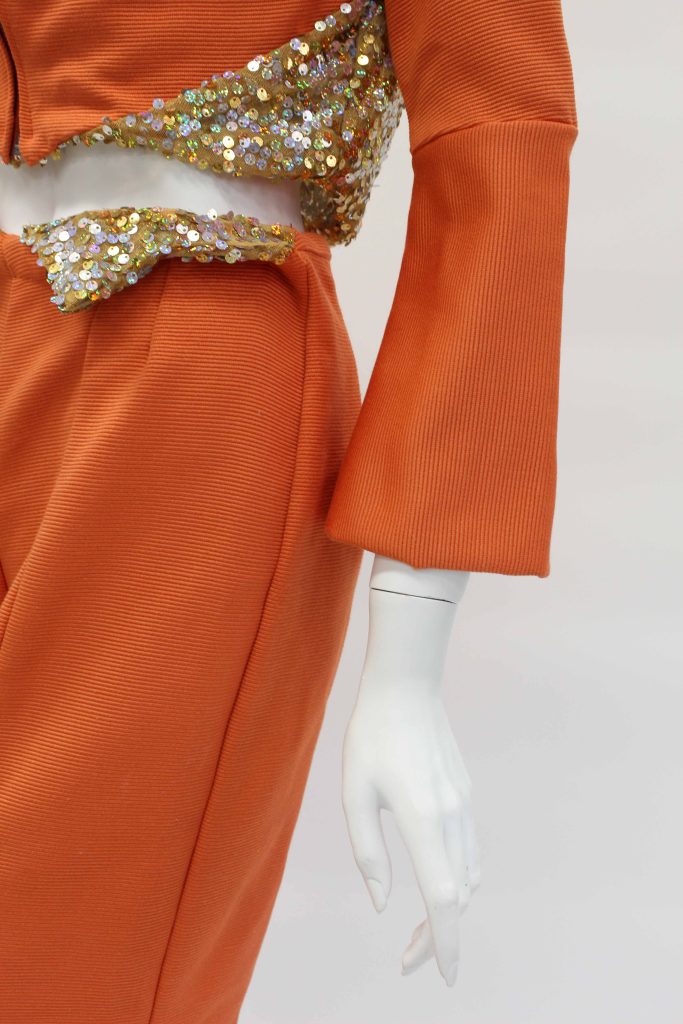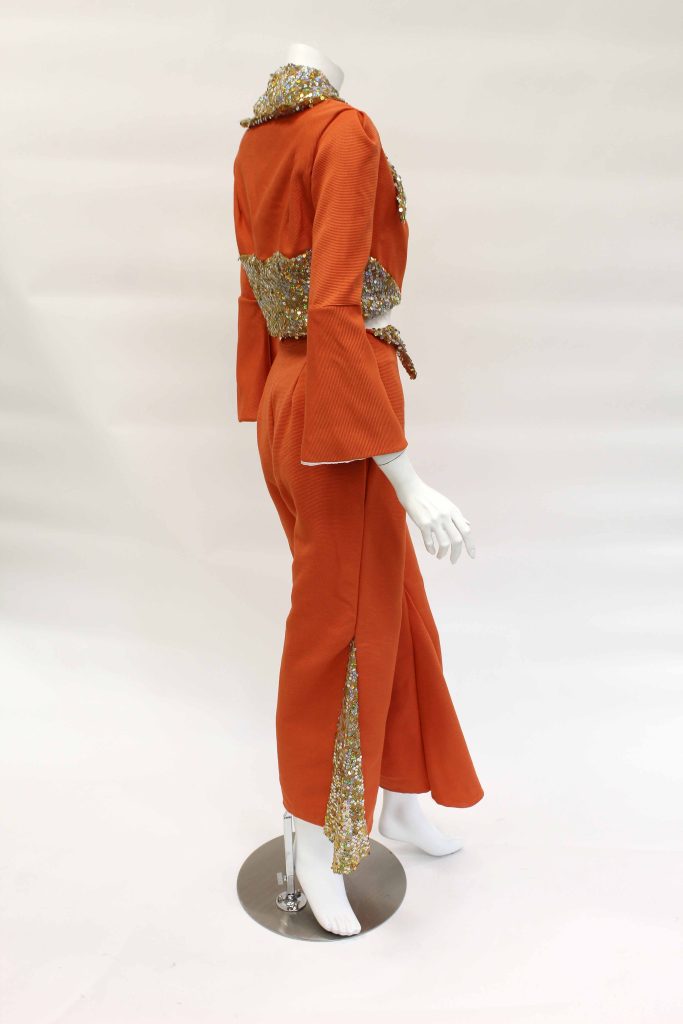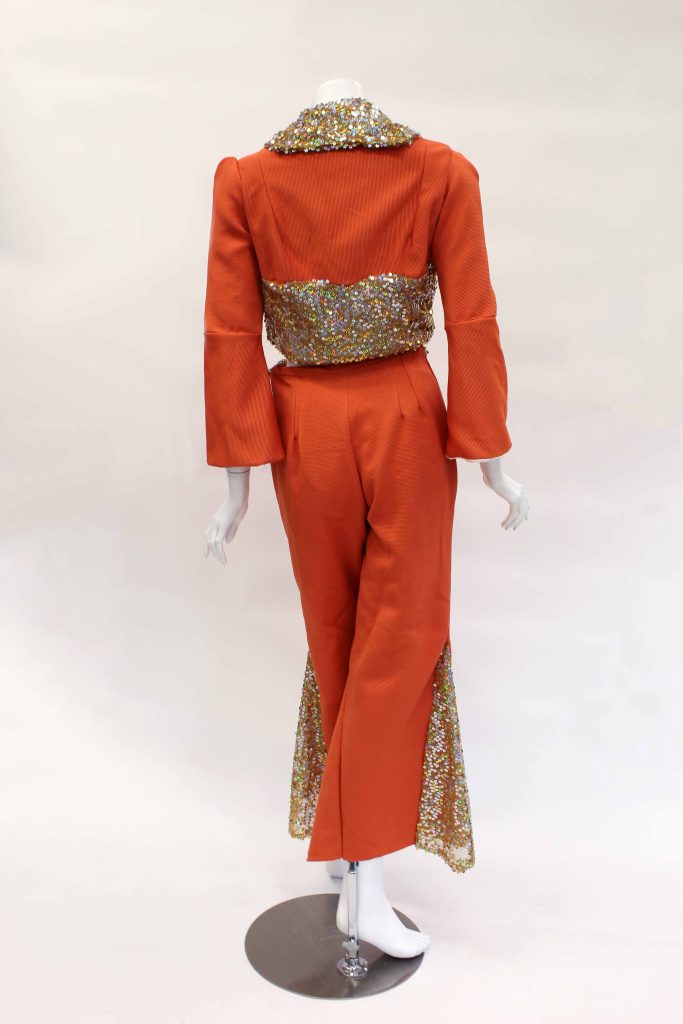TAM 2380: GINGER PROJECT
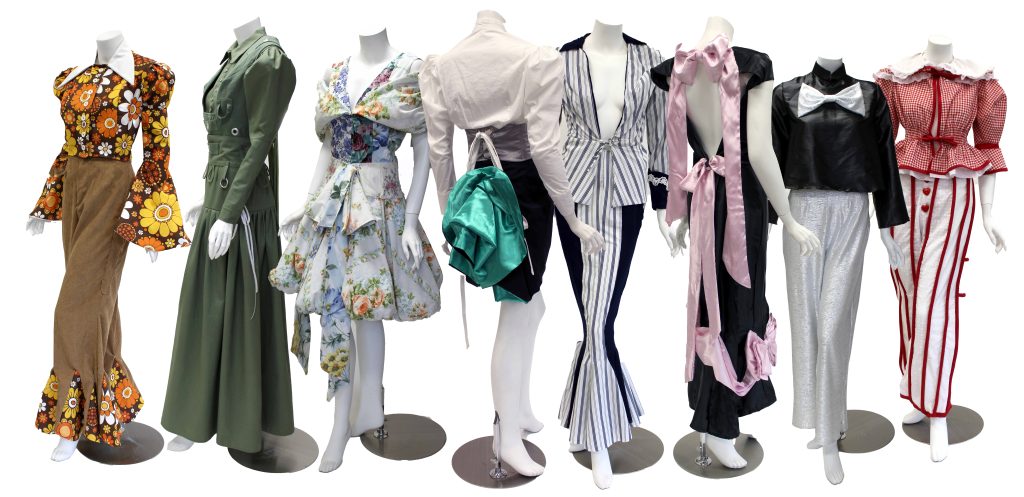
STEP 1: GINGER ROGERS PROJECT
In fall 2023, students in TAM 2380 Patternmaking were prompted to design and execute a matching bodice and skirt/pant ensemble in fashion fabric inspired by Ginger Rogers’ career from the 1930s through the 1980s. After viewing Rogers’ MHCTC garments and archives, students visited MU’s Special Collections and Archives to explore fashion illustrations, advertisements and articles found in period fashion magazines, translating these and other non-apparel items including artwork, architecture, nature, film, and more into their inspiration boards, initial sketches, patterns, and final designs.
STEP 2: RESEARCH AND DESIGN
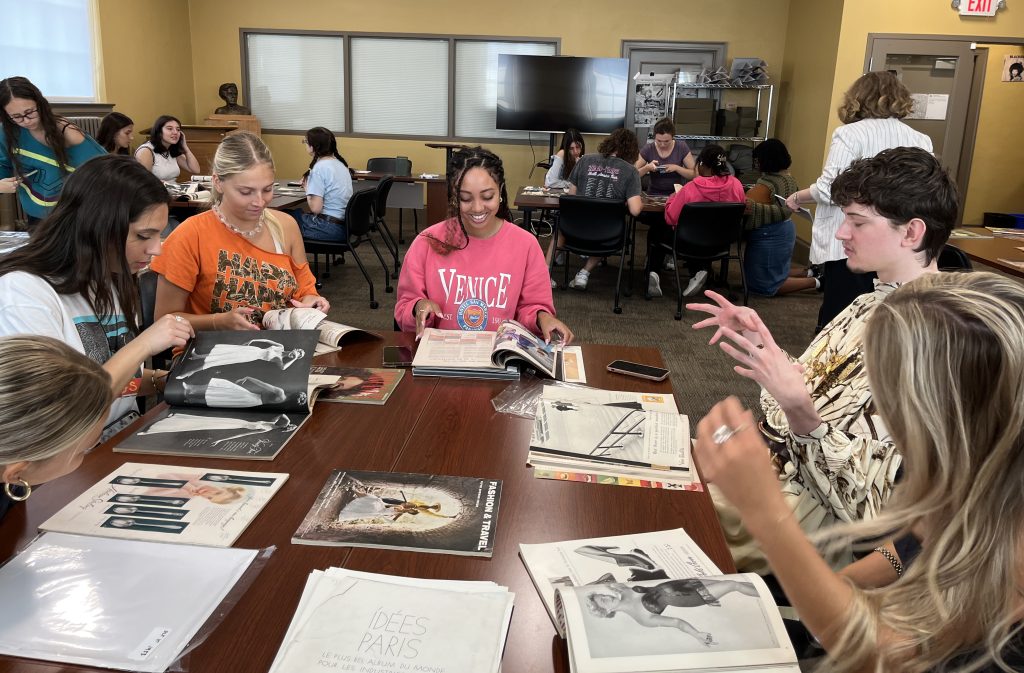
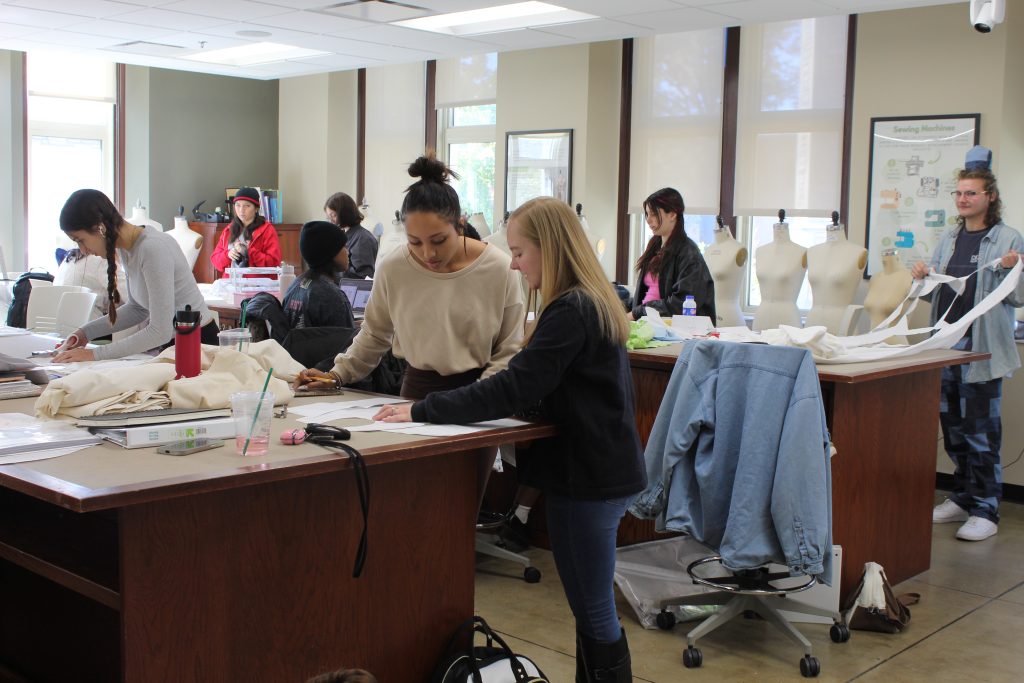

STEP 3: PATTERNMAKING AND MUSLIN CONSTRUCTION
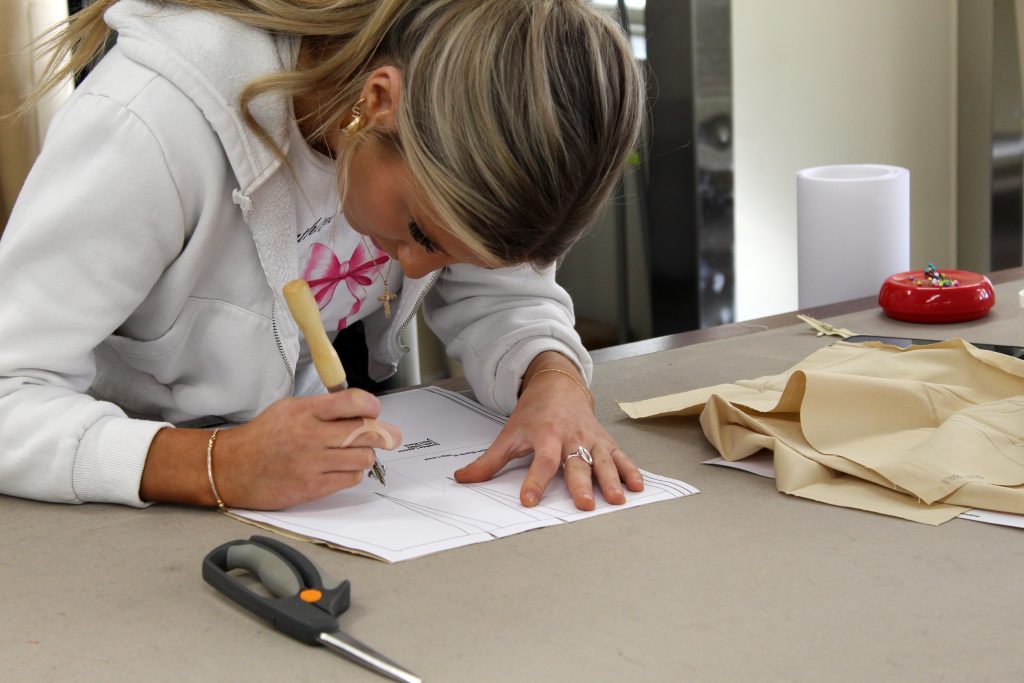
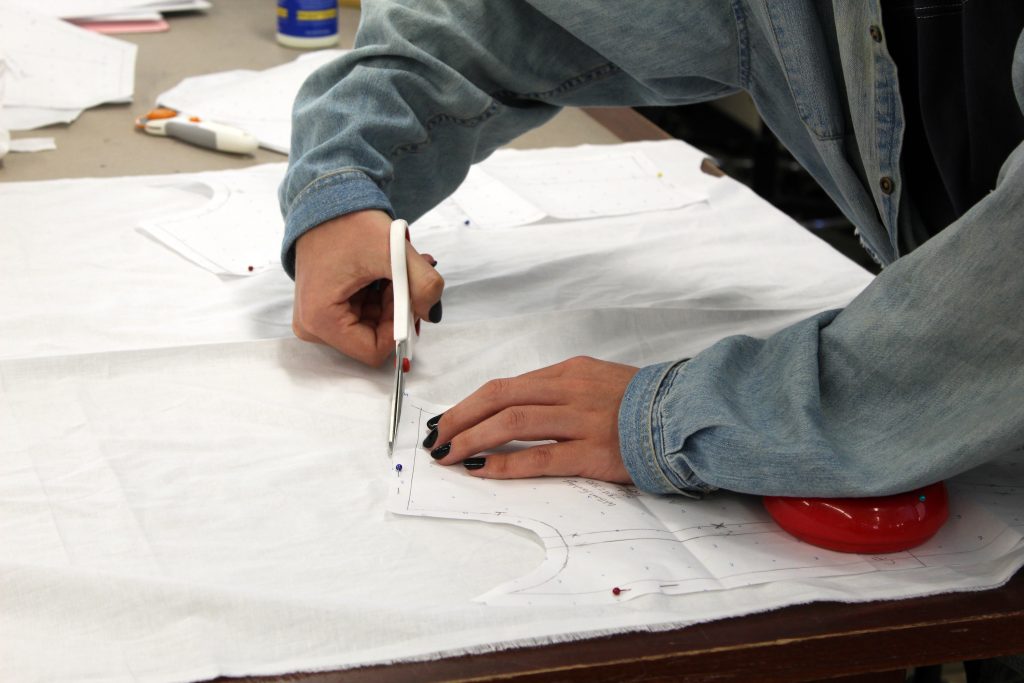

STEP 4: FASHION FABRIC CONSTRUCTION

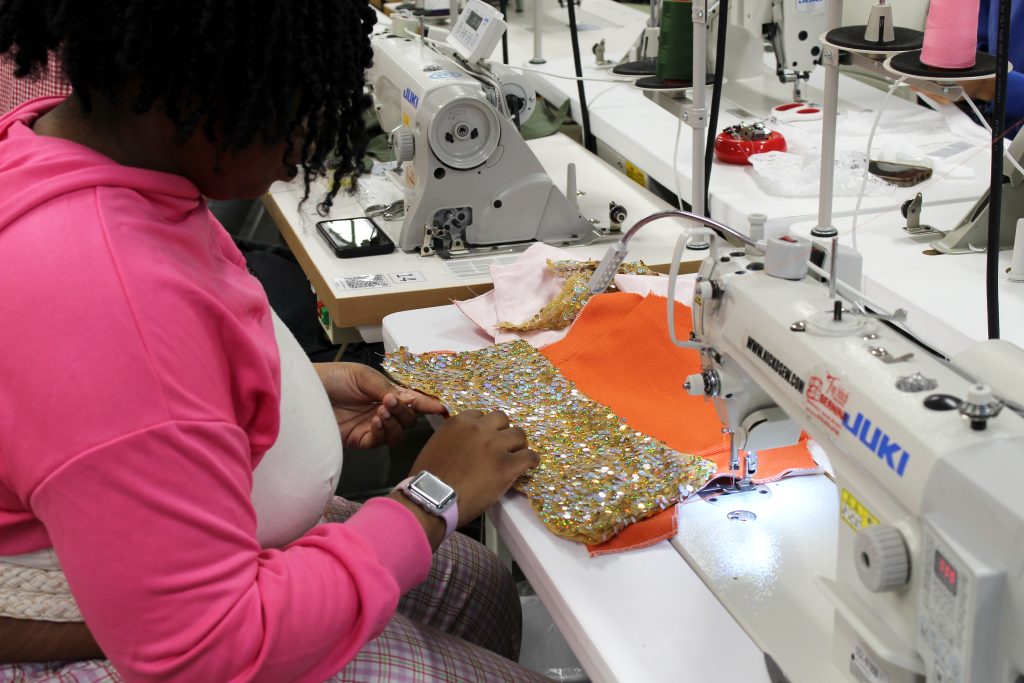
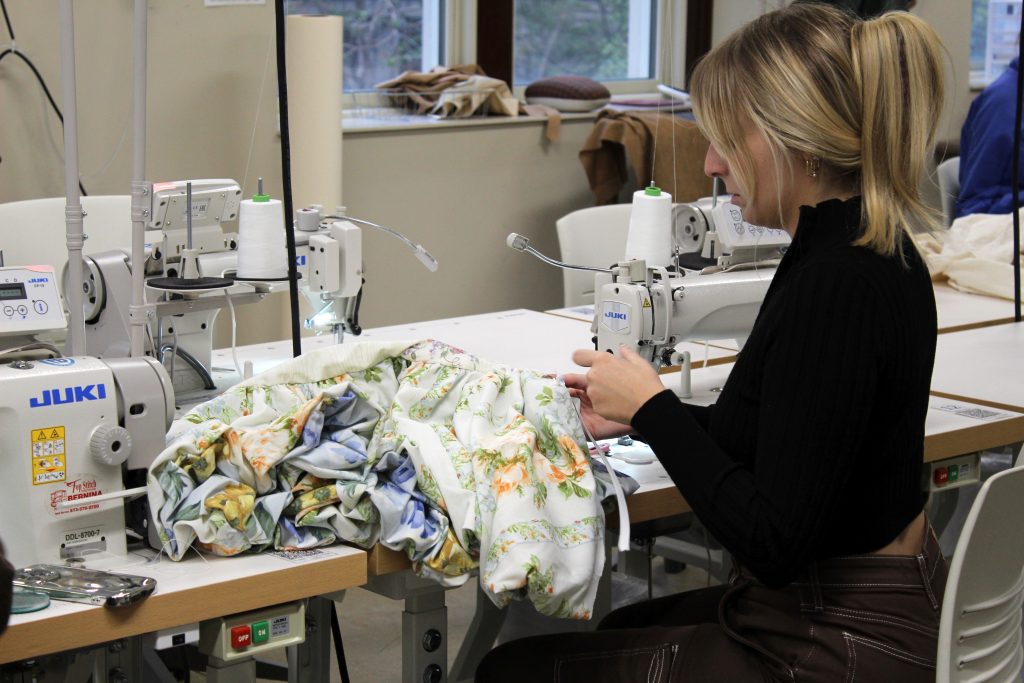
STUDENT DESIGN GALLERY
In alphabetical order: Alink, Alex Oude; Brockhouse, Sabra; Cozzoni, Alyssa; Funderberg, William; Lapour, Sophia; Leonard, Shyla; Manns, Quin; McGuirk, Tyler; Orozco, Sofia; Osborne, Alana; Owens, Tara; Rackers, Zack; Scarpace, Carlie; Southard, Cailey; Speier, Teaghen; Volk, Emma; Washington, Airi
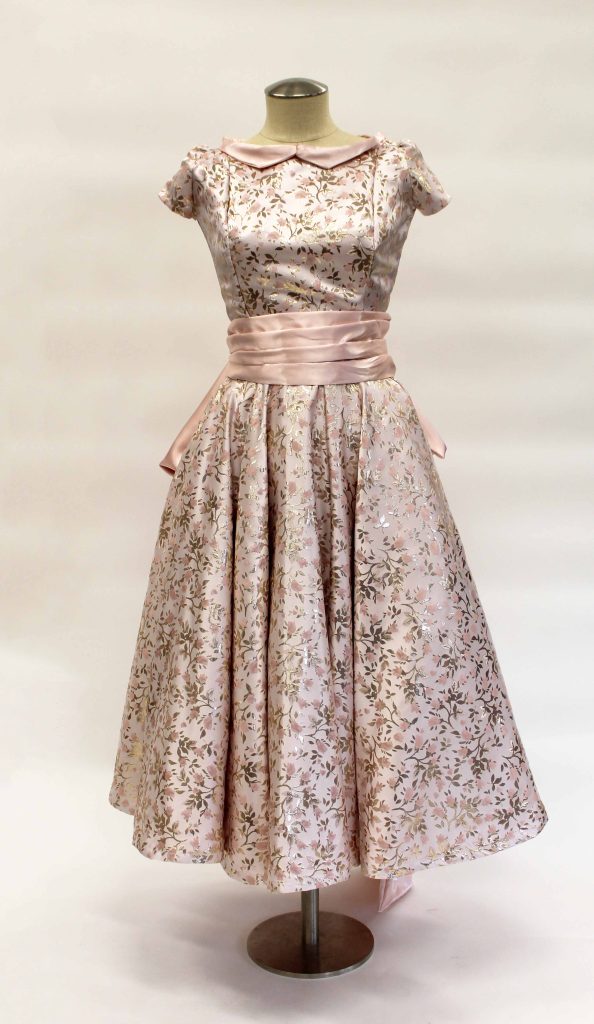
ALEX OUDE ALINK
Ginger’s Night Out
“I took inspiration from the 195’s and tried to showcase that as much as I could in my project while remaining loyal to Ginger’s favorite color, pink. I chose to create a dress with a full circle skirt and cropped hem with cap sleeves and a boat neckline with a sash waistband that leads to a big satin bow on the back of the dress. I also hand-sewed 25 pink bridal buttons down the back of the bodice. I was originally going for a muted, darker color such as a navy blue or forest green, but once I saw this floral pink and gold fabric, I fell in love and knew I had to use that instead. While constructing this garment, I originally cut out four panels for the skirt which made a full circle but because the waistline was too small, I added a fifth panel which added even more flair – the more flair the better!
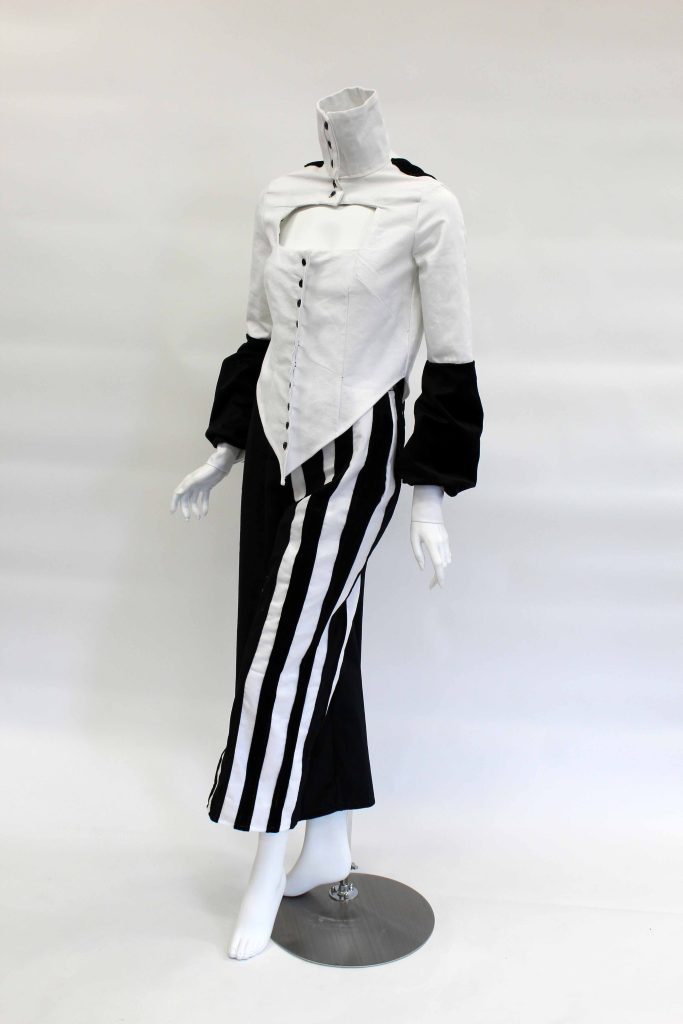
SABRA BROCKHOUSE
Curtains Falling
“My intention for this design was to highlight the lifestyle and dedication it takes to be a world-renowned star. This ensemble is an ode to Ginger Rogers, to her charisma and energy, and passion for entertainment. During the 1950s, television had become a household staple, and attending the movies was all the rage. Theatre was, of course, still popular, but audiences began to migrate from stage performances to the big screen. It was during this time that Ginger experienced less success on film, but the stage was still her safe-haven. For this reason, I chose to build an empty stage over the chest, that would expose the heart of the wearer. I wanted this design emulate the feeling of being lost, or overlooked, to represent the changing times and emotions that Ginger may have faced. This encouraged my choice of using only black and white fabrics, to capture a void. During my research, I was inspired by the stage design used for the musical Singin’ in the Rain, on the set of “Beautiful Girls,” which I felt corresponded with image and reputation of Ginger. The wide leg and lantern sleeves in black velour imitates those draping curtains, while the panels of white denim along the other leg allude to the stairs descending on stage.“



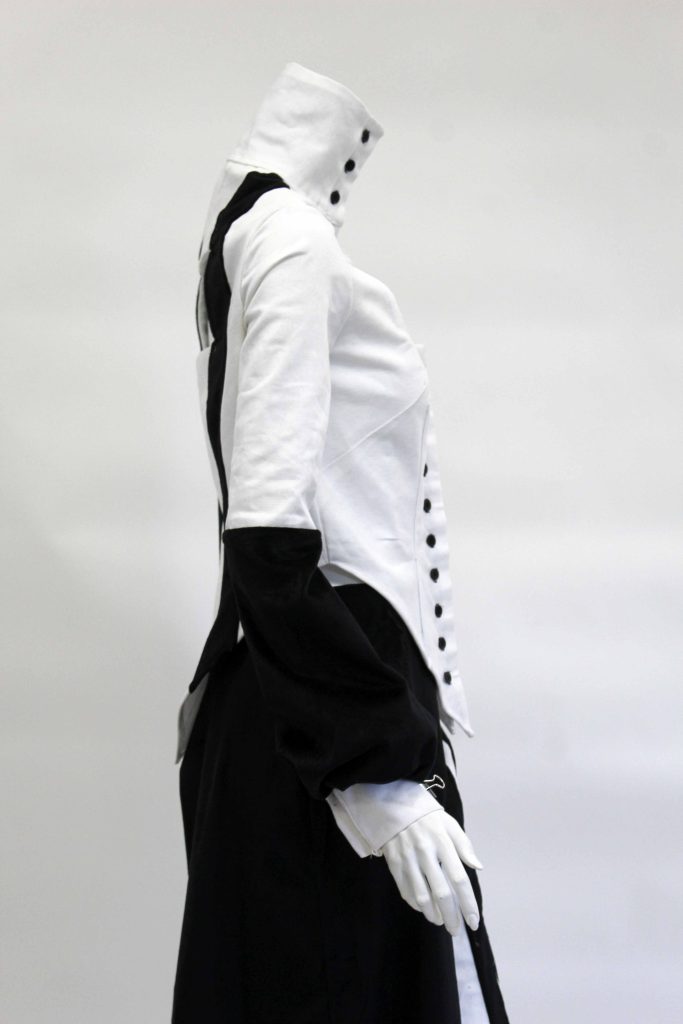
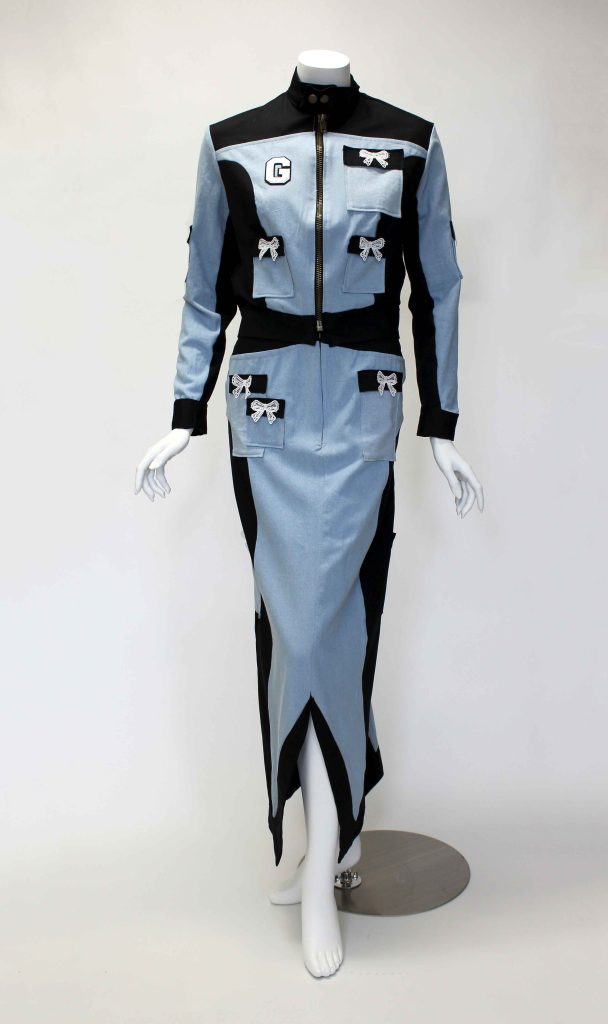
ALYSSA COZZONI
Blue Collar Beauty
“”Blue Collar Beauty” took inspiration from an array of sources including the 1940s war era, as well as Hollywood actress and star Ginger Rogers. I first dove into researching women’s workwear styles and even the army uniforms worn in the 1940s. The new need for women in these blue-collar jobs during the war drastically changed the face of fashion at the time. Two key artifacts that influenced my design choices included a war cartoon depicting the “1943 Lady of Fashion,” and a painting by Jose Clemente Orozco titled “Dive Bomber and Tank.” In addition, I envisioned what Rogers would wear in this period as a female air force pilot or a young woman working long days in the factory. Ginger Rogers was no stranger to rolling up her sleeves and putting in hard work throughout her career, but she never sacrificed the glamour of her wardrobe. Through this piece, I tried to balance the ruggedness of blue-collar work with the femininity embodied by Ginger Rogers. Fabric choices such as denim became key, along with a blue-and-black color scheme; the addition of a brass antique metal zipper and snap closures help convey the hard-working origins of the piece. In contrast, I added a touch of embellishment with the personalized “G” patch for Ginger on the jacket and the lace bow appliques. The garment represents the evolution of my knowledge of patternmaking in conjunction with the challenge of glamourizing workwear, through the struggle of balancing what may look like “too much” and adding more anyway because that is what Ginger would have done.”
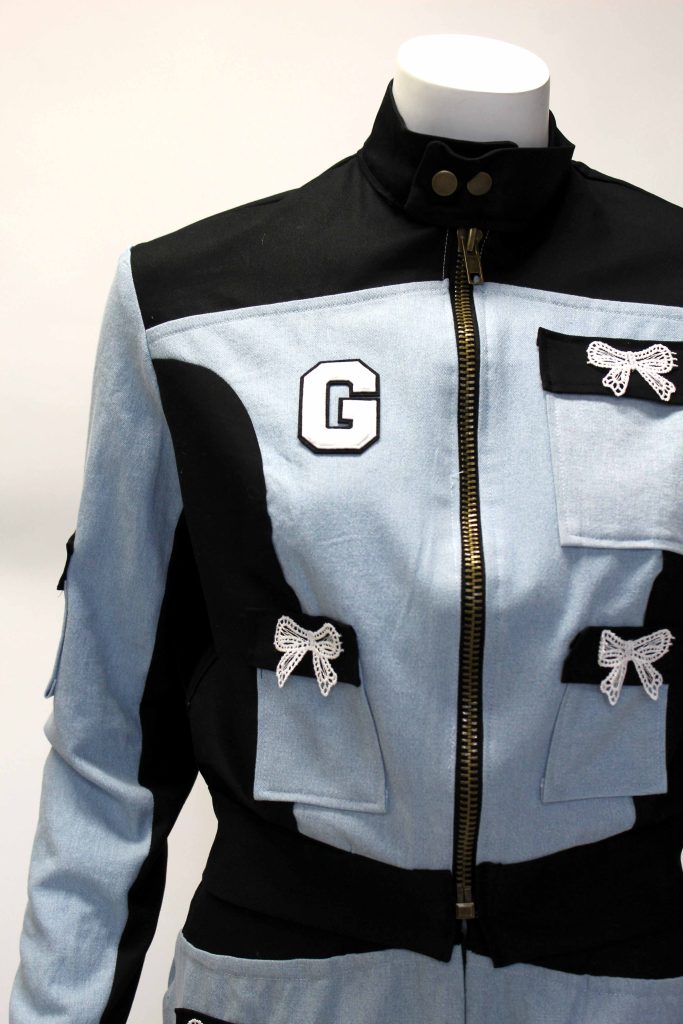
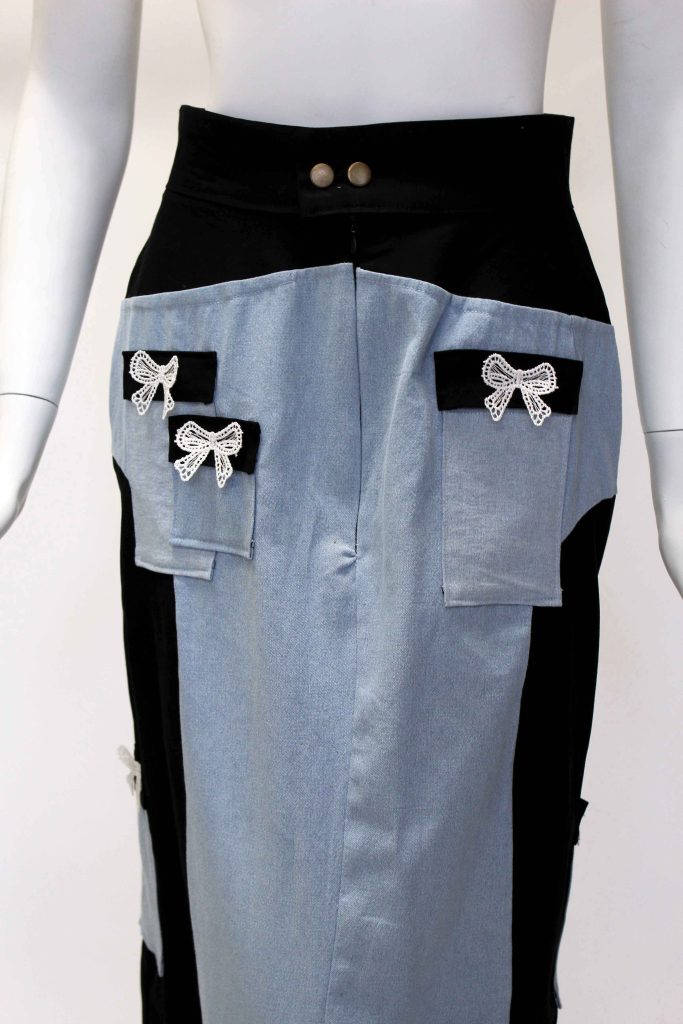
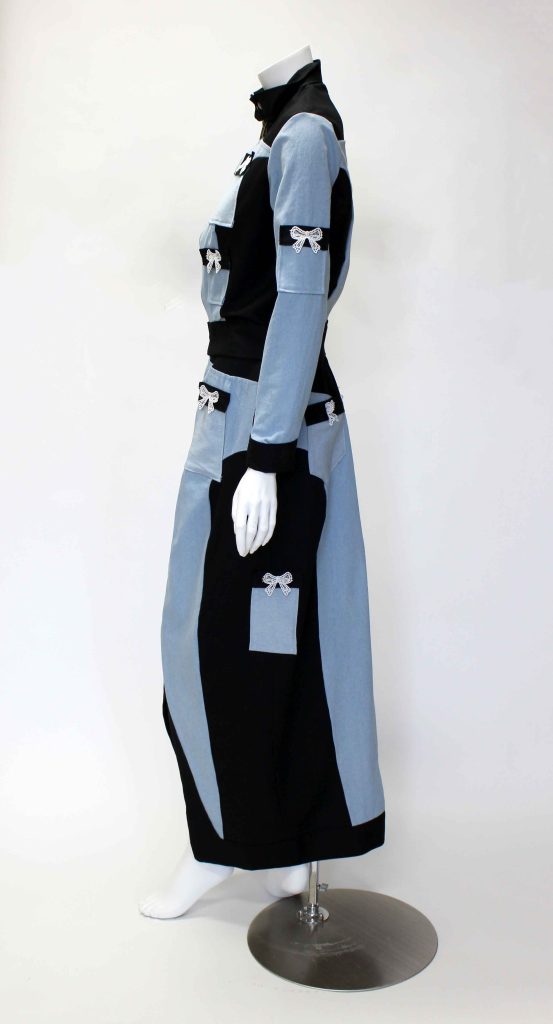
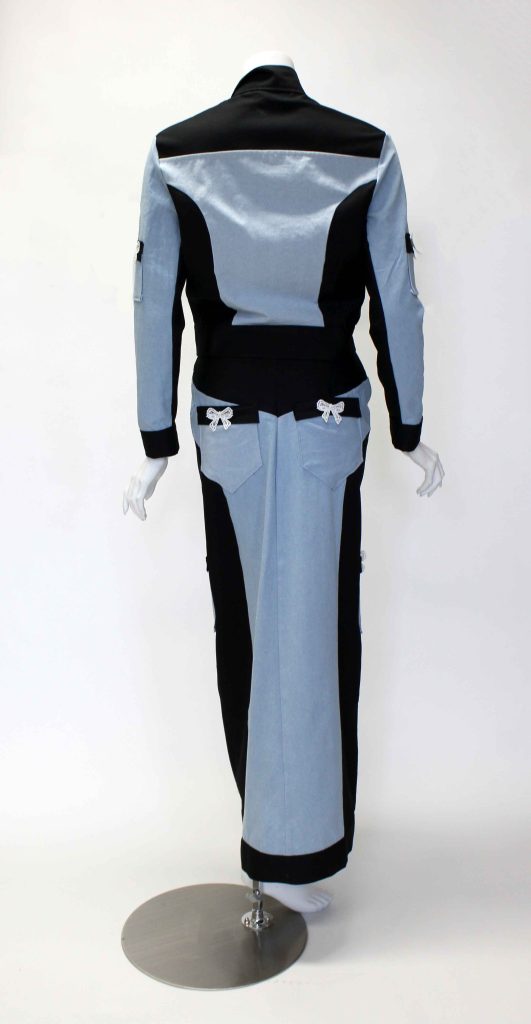
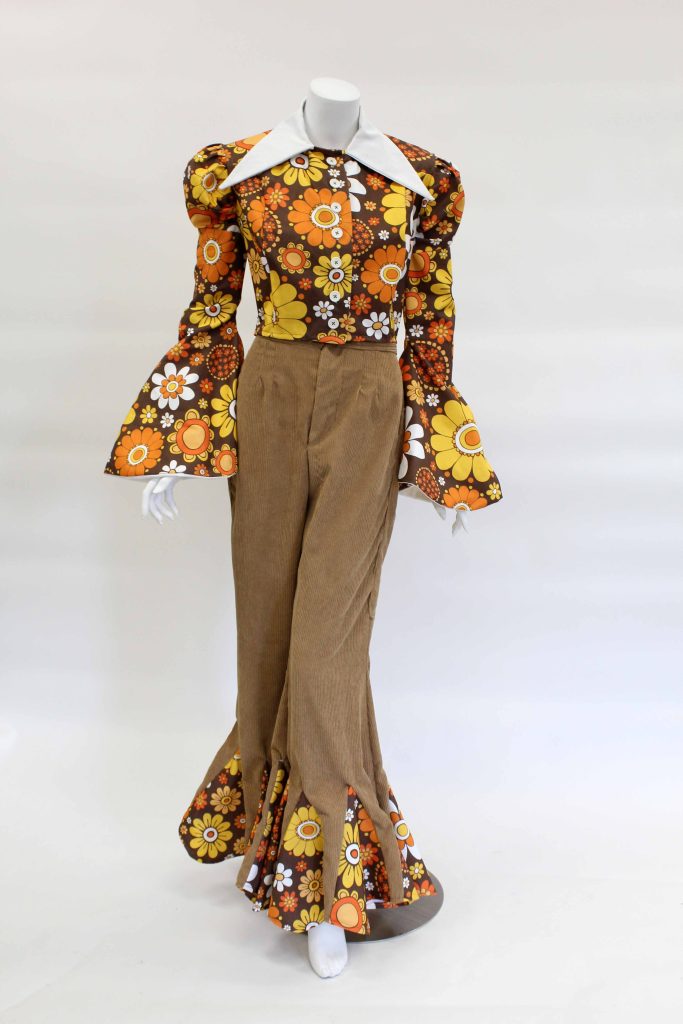
WILLIAM FUNDERBERG
70s-Inspired Outfit
“For my inspiration, I drew from 1970s decor, from the floral wallpaper designs to the chairs and their textiles and design elements. I used both a 70s floral pattern and corduroy along with other design elements. For my design process, I wanted to take inspiration from both 70s fashion and Ginger Rogers’ fashions. Along with the period’s classic bell bottoms and bell sleeves, I wanted to add more drama and danceability with godets on the bell bottoms and a dramatic sleeve and collar. For my patternmaking process, I drafted the shirt using paper turning the darts into princess seams, adding yokes, and adding drama to the sleeves and collar. For the pants, I drafted each piece using CLO3D including the waistband, godet, fly front, pocket, and side appliqué. This look portrays the 70s from head to toe with the flare and uniqueness of Ginger’s style.”
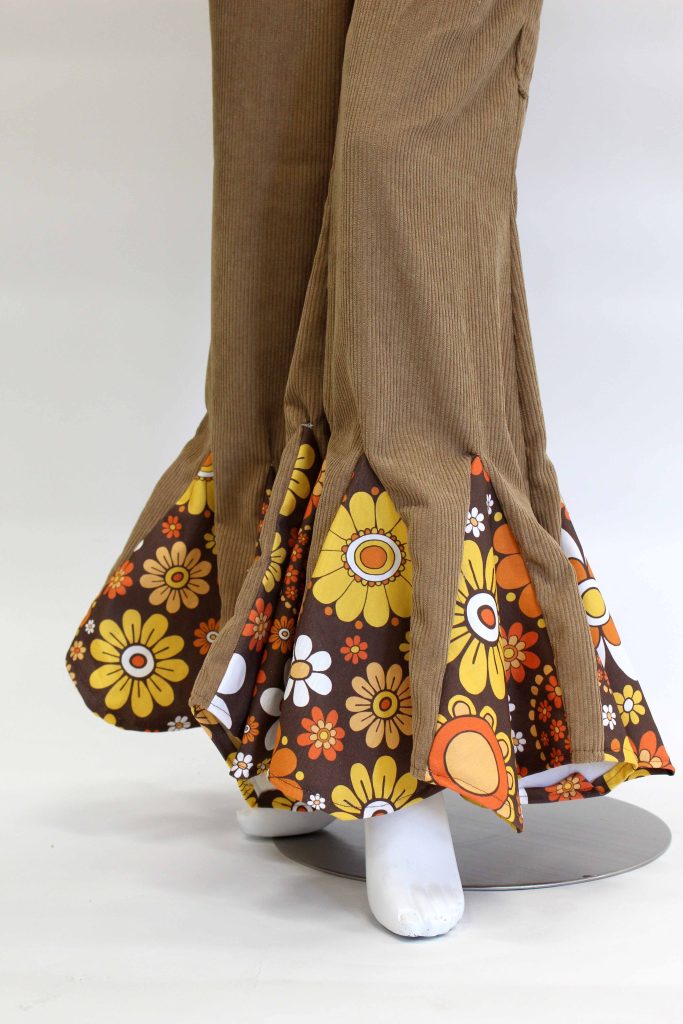
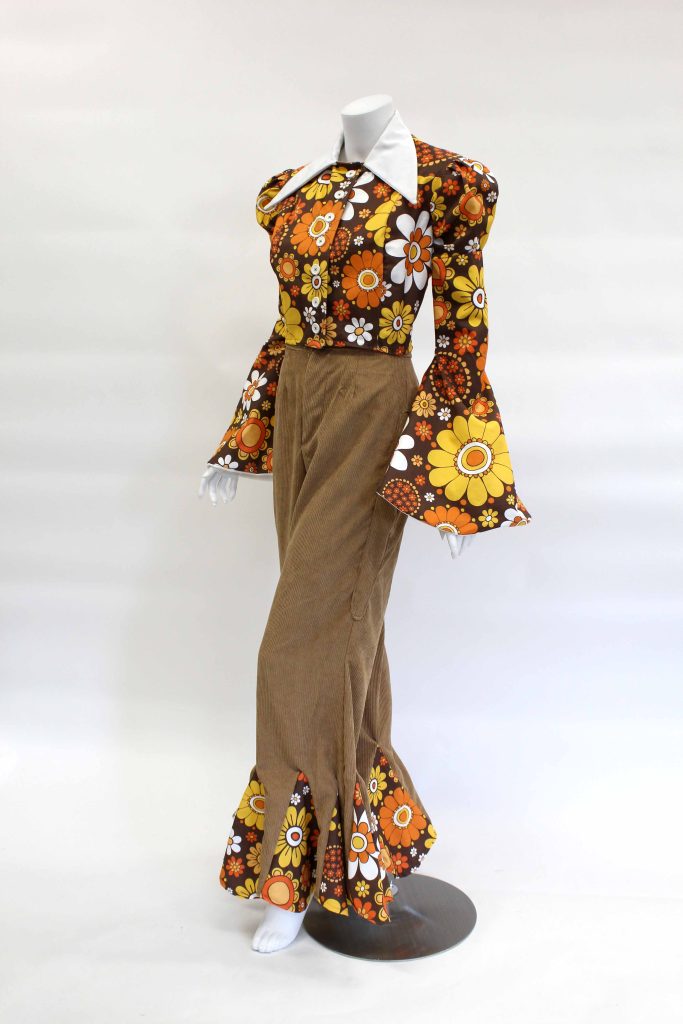
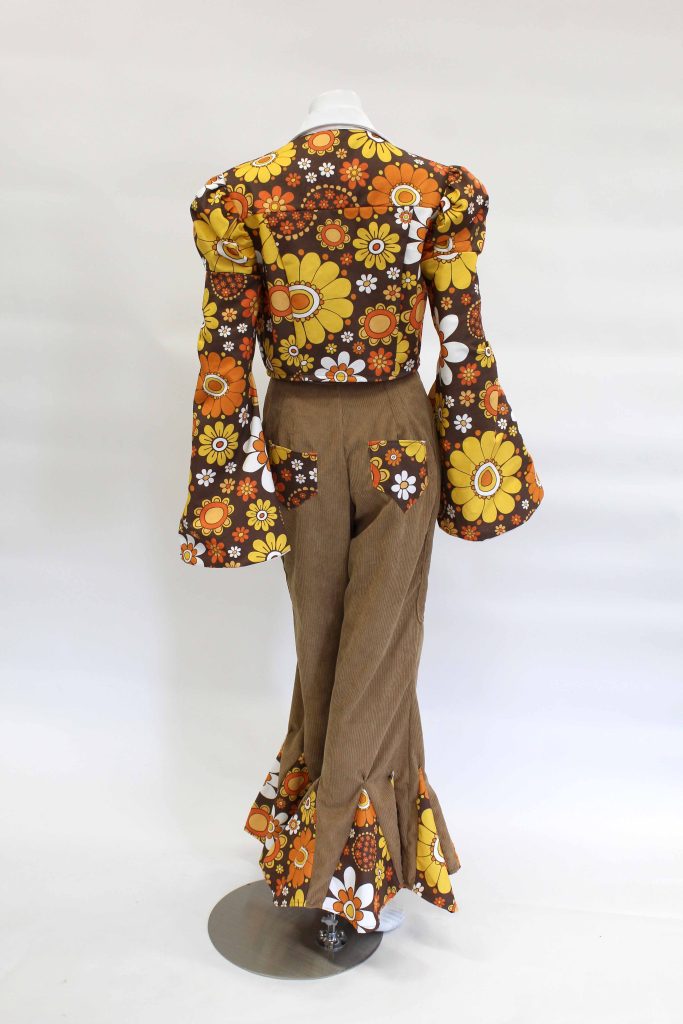
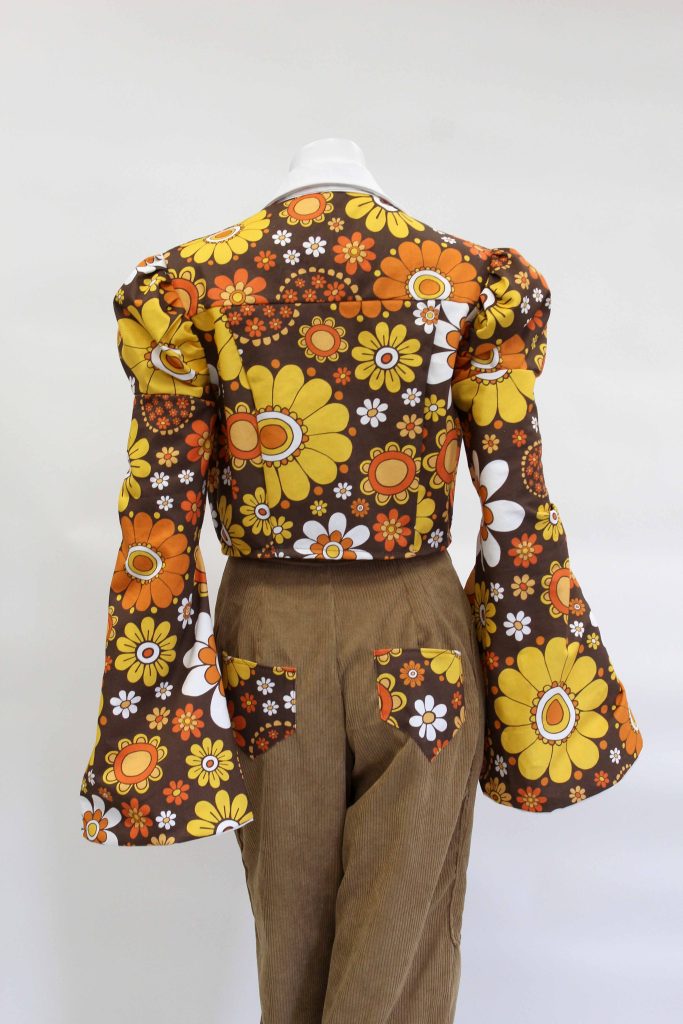
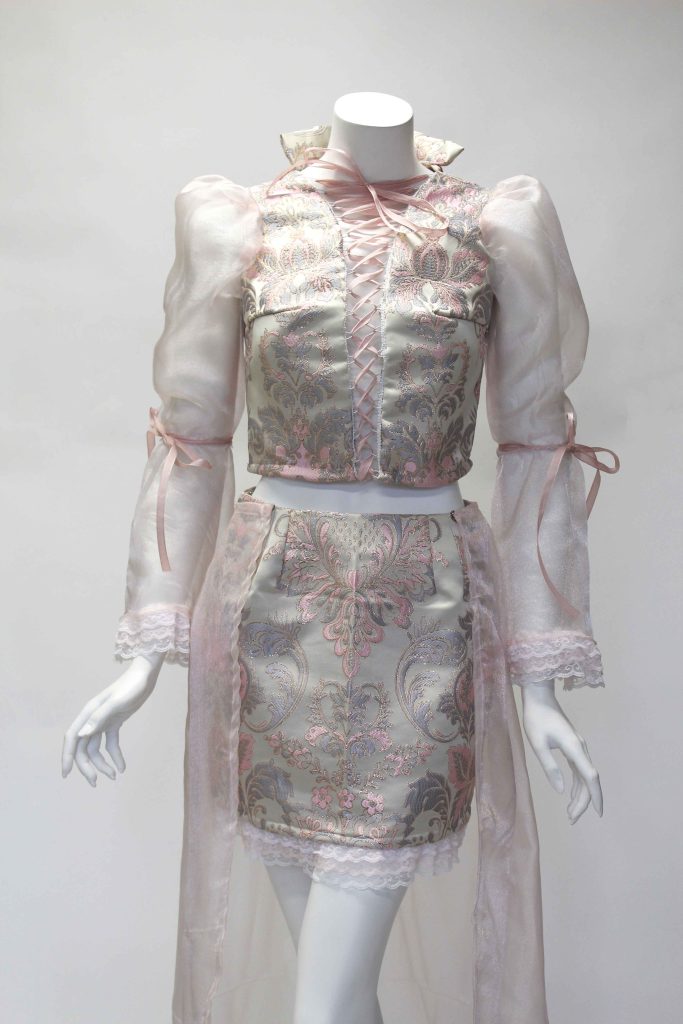
SOPHIA LAPOUR
Modern Day Cinderella
“Glitz, glam, and princessy make up Ginger Rogers and Cinderella. Ginger and Cinderella go hand in hand, inspiring my design, Modern Day Cinderella. Cinderella had first come out in the 1950s, so I knew that was what I wanted to do. My first step to gather the whole aesthetic was to select fabric. I instantly knew a most beautiful Victorian and princess type fabric was the one. The pink was inspired by Cinderella’s pink dress made by the mice, as were my bows. When designing my dress, I wanted it to be fun and different. For the bodice, I wanted a dramatic front with an open corset lacing. I didn’t want to just do a mini skirt so adding a sheer skirt overlay really made the overall final piece. The puffy sleeves were added to really bring out the Cinderella and girly vibe. Looking at the final garment I knew this would be a piece Ginger would wear because of its uniqueness and overall aesthetic.”

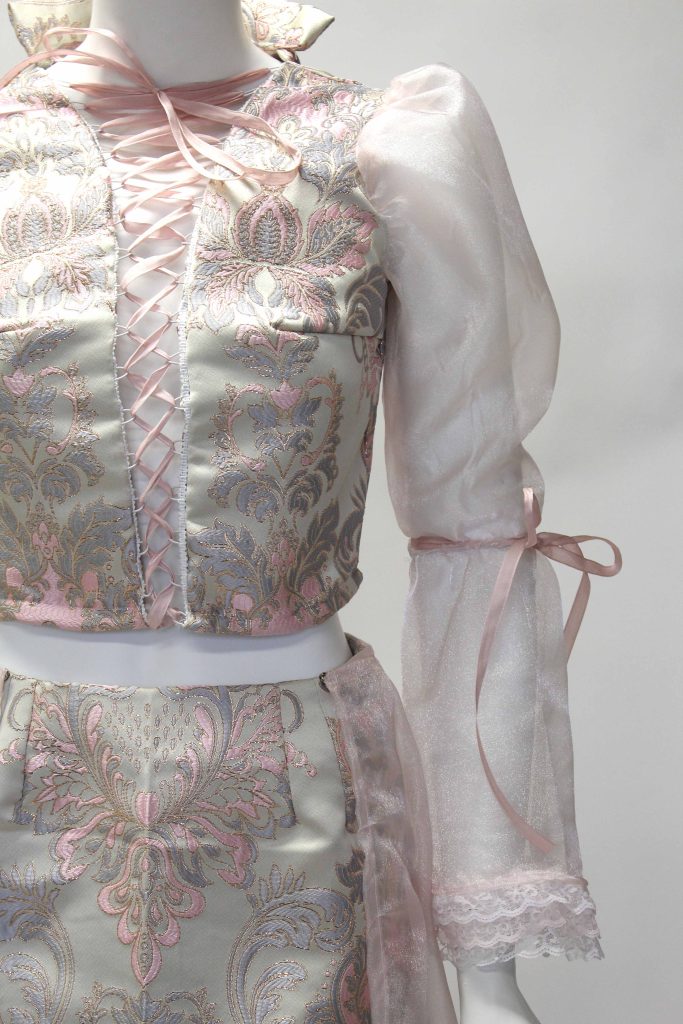
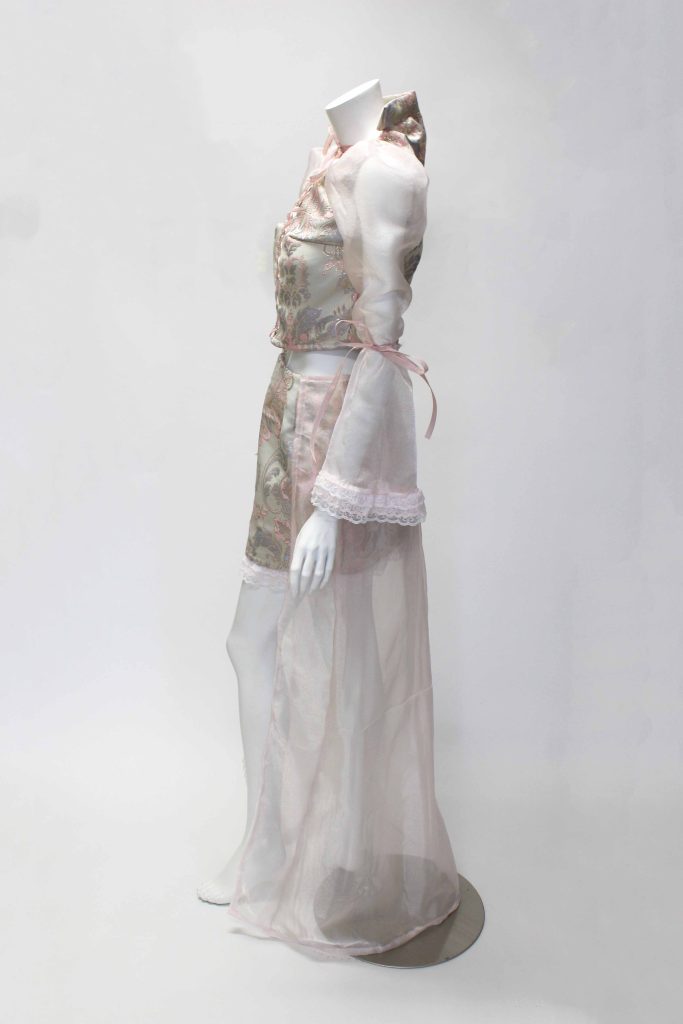

SHYLA LEONARD
Pearls for Equality
“The on-screen relationship between Ginger Rogers and her dance partner Fred Astaire was described as implementing sexist ideas when evaluated in the modern day, especially the kisses they shared on screen and their relationship on and off camera. My inspiration from the decade includes the film Monkey Business starring Ginger Rogers as well as sexism in the film industry. An article written about the film describes a scene in which Ginger performs marital duties in her home; Ginger is revealed to be wearing only an apron, thereby sexualizing the expected role women played while also adding to the sought-after “youth.” The last picture captures a pencil silhouette I plan on taking a lot of inspiration from which also signals the unrealistic standards women were to present with. The pencil silhouette became increasingly popular in the 1950s along with bouffant skirts.“

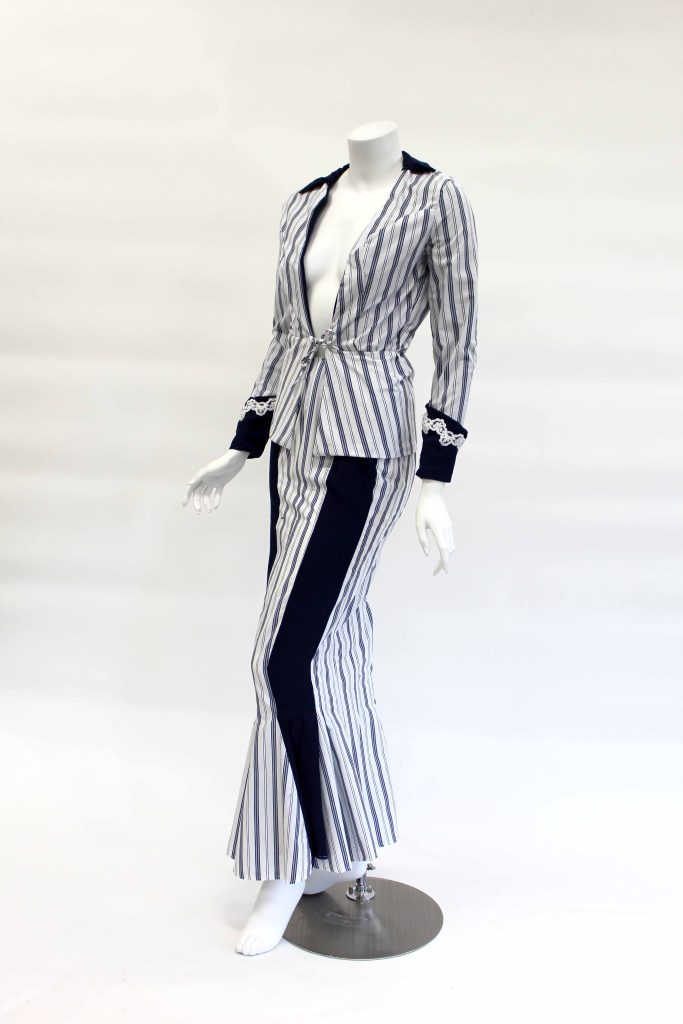
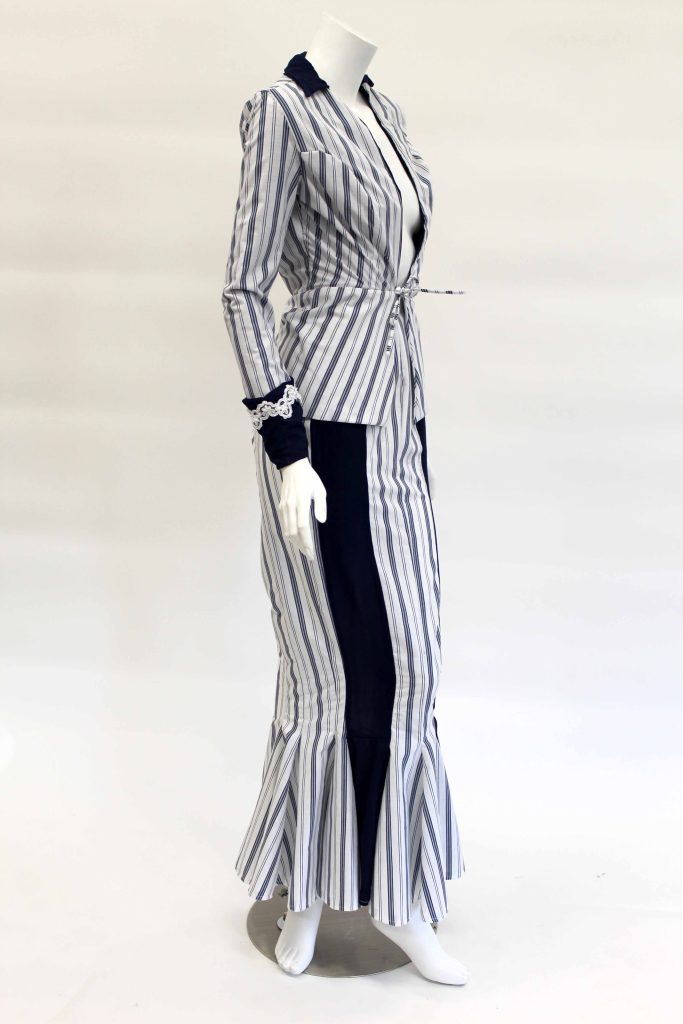
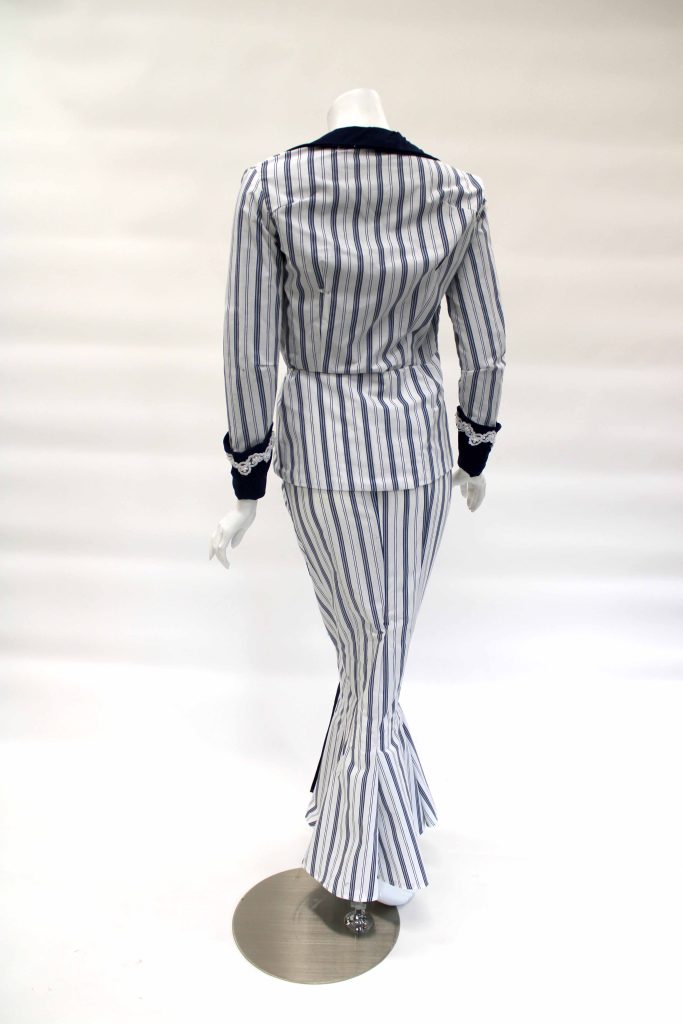

QUIN MANNS
Ginger Bodice and Pants
“When designing for this project, I wanted to showcase a different side of Ginger’s life that most do not see or think about. Ginger Rogers was a woman with regular hobbies and interests like everyone else. She owned an Oregon ranch, and while there she would live her everyday life. I gathered most of my inspiration imagining her personal life. My project was also inspired by the 1960s, specifically the 1967 Summer of Love festival. I also found artistic artifacts created in the 60s to gather inspiration from. This includes Yayoi Kusama’s “Infinity Mirror Room”, John Hejduk’s “One-Half House”, and Claes Oldenburg’s “Floor Cake”. Each piece contains a lot of texture and shape that I wanted to slightly replicate with my project. I took a lot of color and pattern inspiration from Kusama; this can be seen through my use of red, white, and polka-dotted fabrics. I wanted my pants to slightly project out from itself much like her sculpture. That is where I got the idea of adding piping to the pants.“
“Hejduk used design principles from Cubism, which focuses on the fragments of geometrical forms, and this greatly inspired me to add vertical lines to the front of the pants and horizontal lines to the back. Hejduk’s philosophy when making his piece was “using the mostest with the leastest,” and I found that to be so interesting. I wanted to try that out by making my shirt the “mostest”, with the loud gingham and ruffles, and my pants, being the “leastest” with its minimalistic sleek look.”
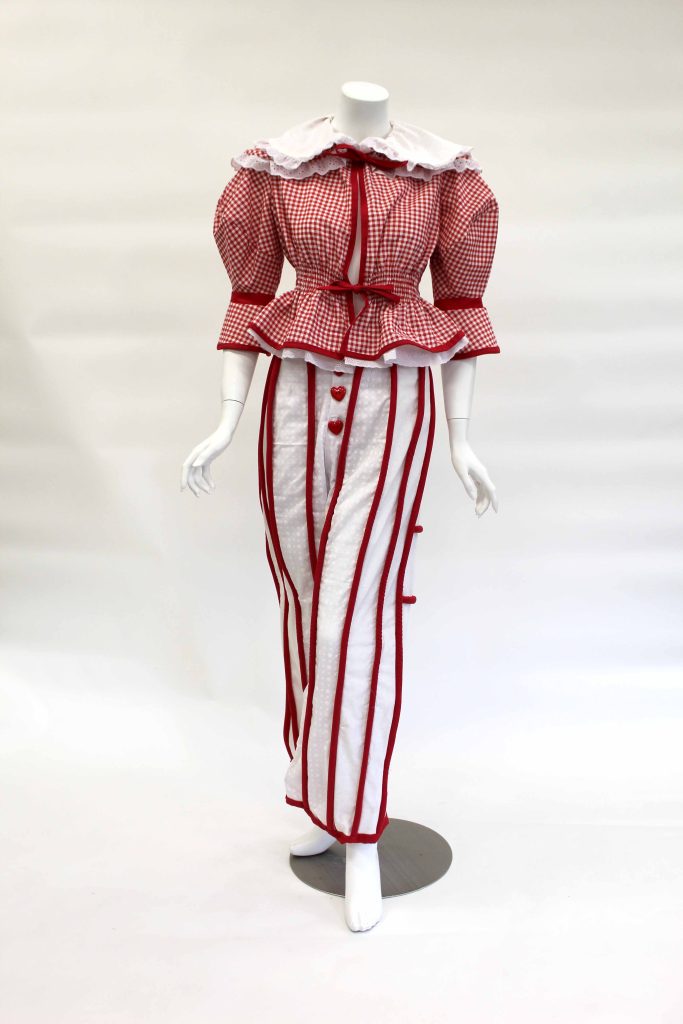
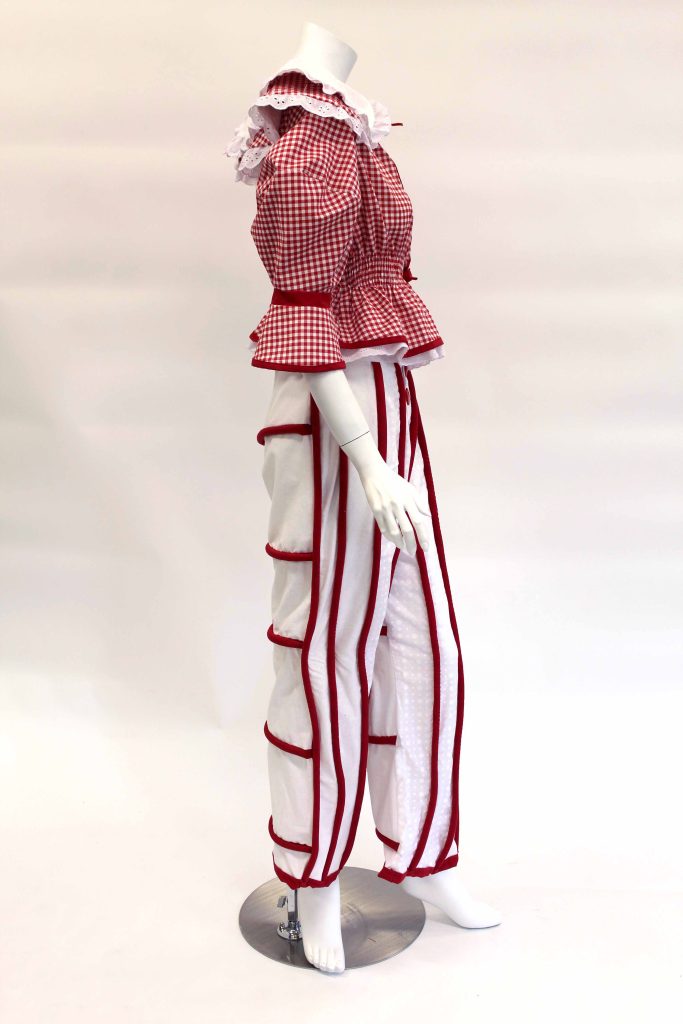
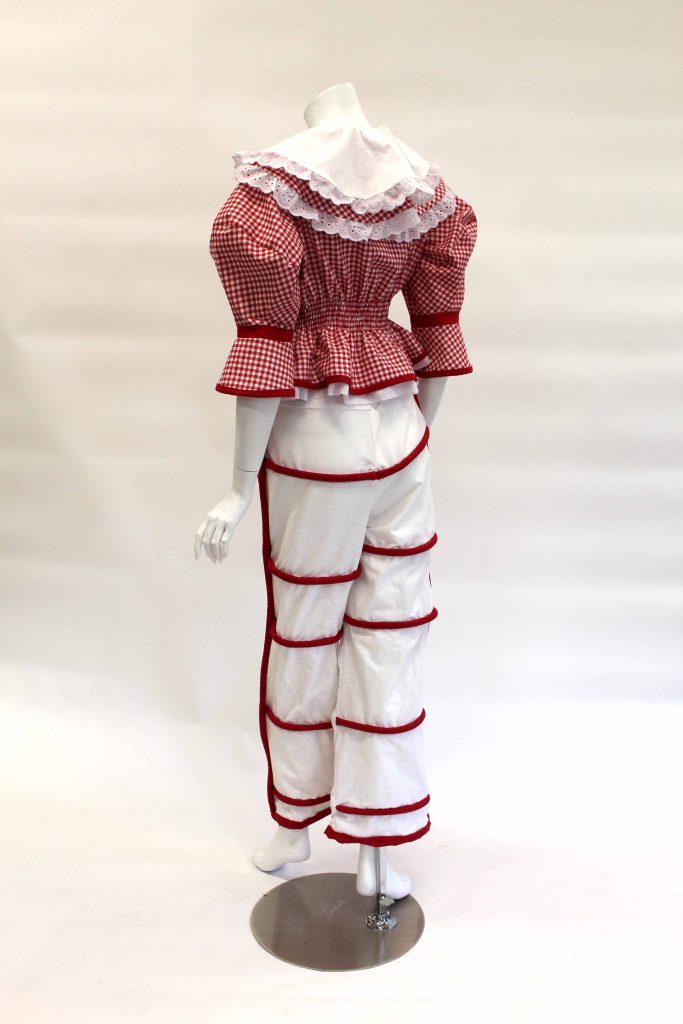
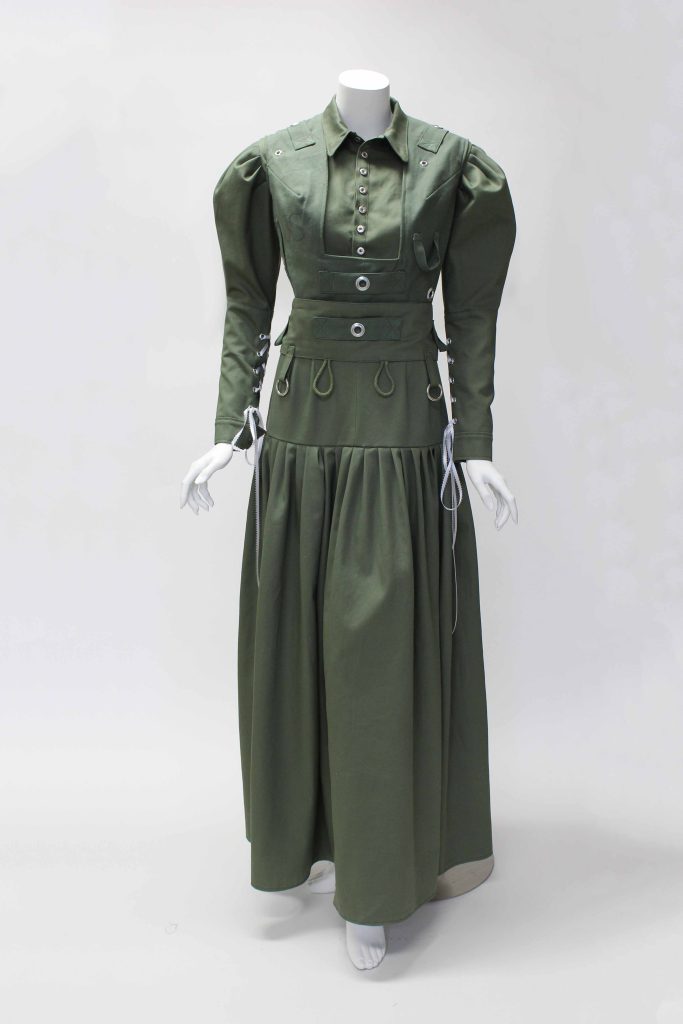
TYLER MCGUIRK
Ginger Rogers Ensemble
“My creative process drew from a myriad of inspirations with the 1940s serving as the predominant muse. I carefully selected three distinct sources from the era: Ginger Rogers’ film “Tender Comrade,” the iconic Mobile Oil building, and the WWII Diamond T 968 4-ton 6×6 truck from WWII. The choice of “Tender Comrade” as a pivotal inspiration stemmed from its alignment with the 1940s and its wartime narrative. To showcase this influence, I constructed a refined button-down bodice with extravagantly puffed sleeves, reminiscent of the shirts adorning Ginger in the film. Channeling the industrial allure of the Diamond T 968 4-ton 6×6 truck, I translated its rugged essence into a garment fashioned entirely from an army-green cotton fabric. The incorporation of eyelets, metal rings, and metal buttons mirrored the truck’s sturdy metal frame.”
“Additionally, I crafted a vest out of an old military laundry bag, using its thick army green fabric to also show off the features of the Diamond T. The vest nodding not only to the truck but also echoing Ginger’s attire in a memorable scene from “Tender Comrade, where she can be caught wearing a square neck vest.” Drawing inspiration from the architectural marvel of the 1940s Mobile Oil building, I meticulously designed a pleated skirt adorned with sixty pleats in total. Each pleat emulated the building’s clean lines and geometric shapes, harmonizing the ensemble with the structural finesse of contemporary architecture. These inspirations come together in a timeless masterpiece that pays homage to the elegance and innovation of the 1940s.”
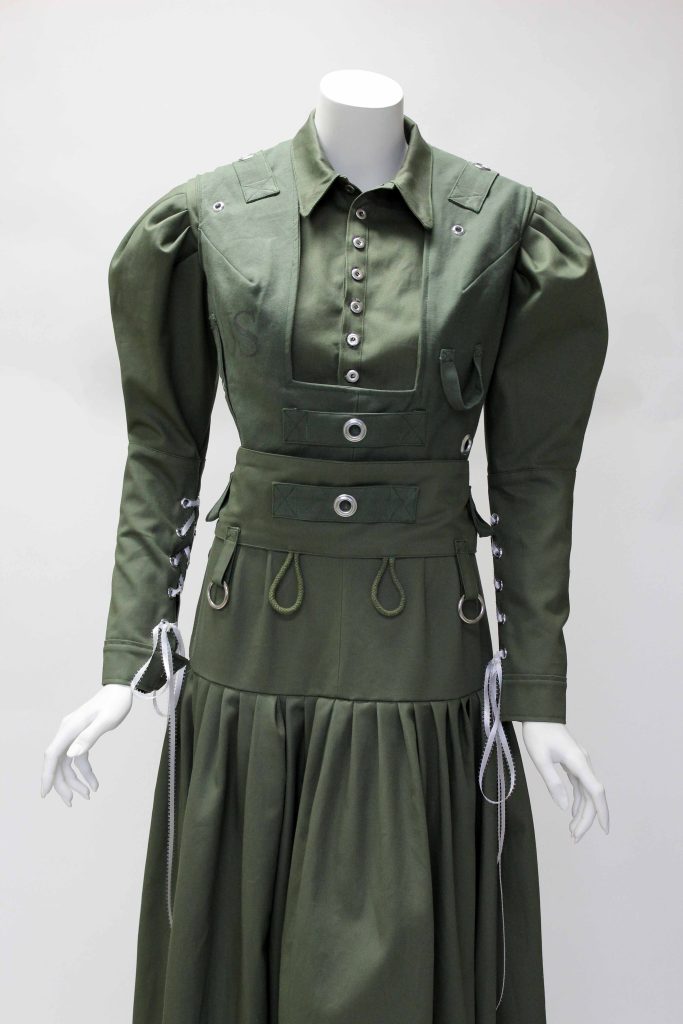

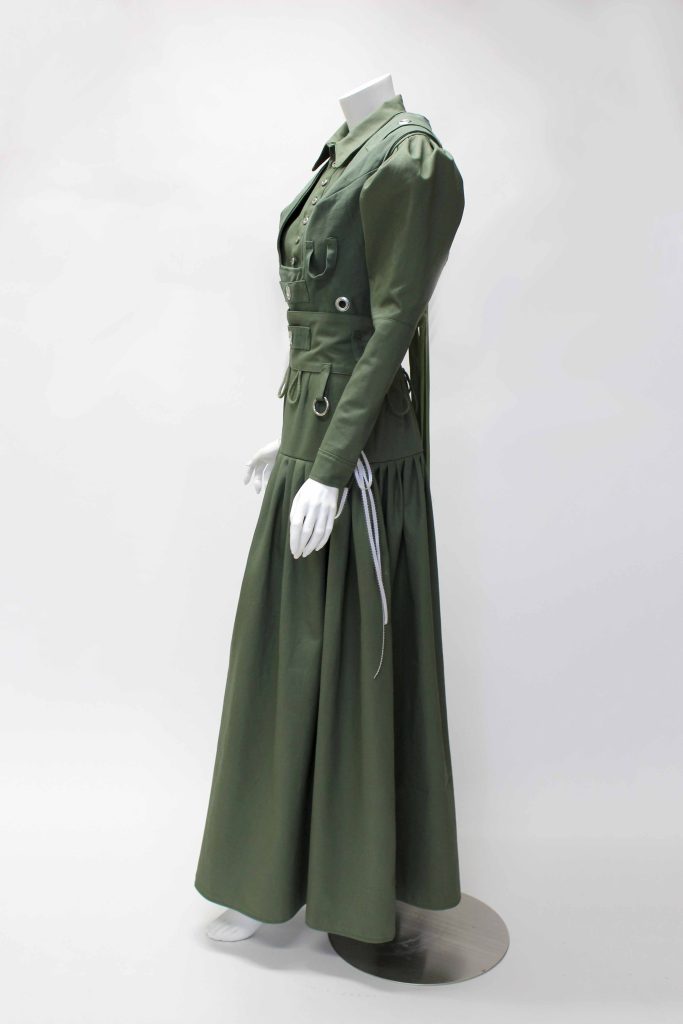
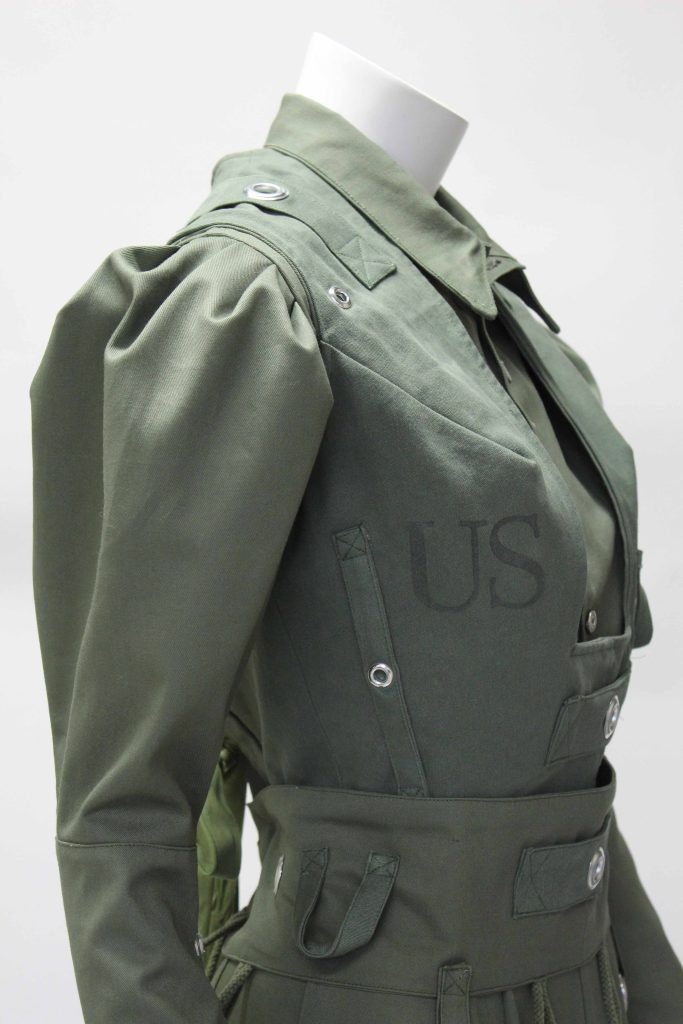
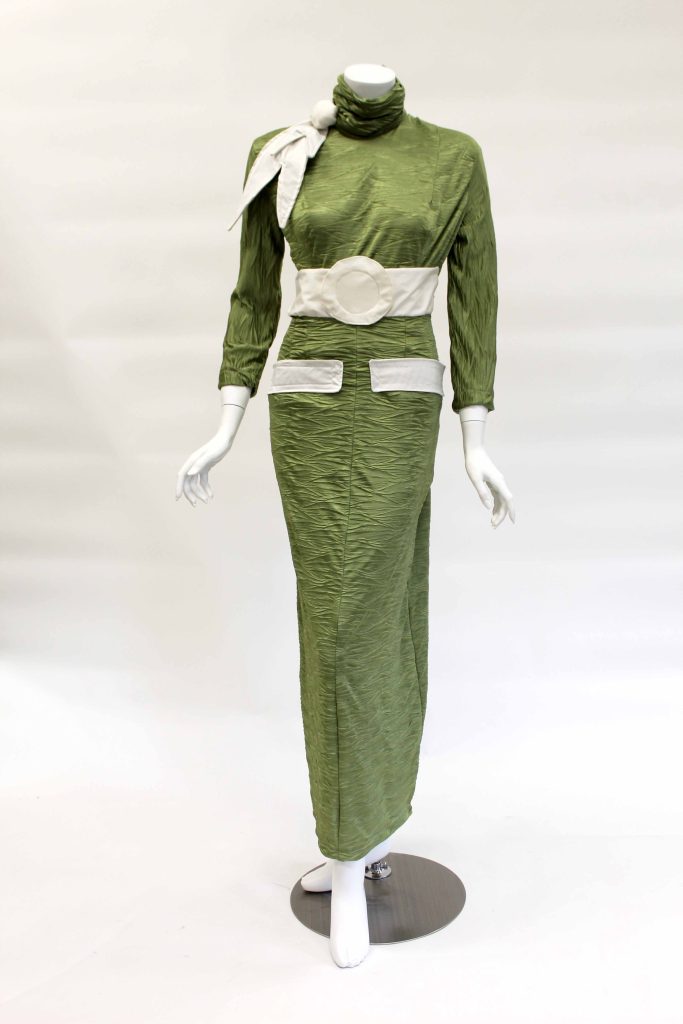
SOFIA OROZCO
Ginger Rogers ‘60s Ensemble
“Picking to work with the 1960s as the decade of inspiration, I was able to research the Space Race and Stonewall, as I wanted a significant event from this era to be added into my garment. There was constantly changing fashion as well as important historical events that influenced apparel choices and designs of this era. I decided on the 60s because I find myself continually drawn to the futuristic, social reform-oriented, and retro-inspired apparel of this decade. And for the main source of inspiration, Ginger Rogers has a very elegant and classy fashion history. What I drew inspiration from is her elegance and glamour while also focusing on the powerful looks she had and some of her more masculine looks. She has such a distinct feminine, over-the-top, glamorous look, and this is something that is a staple of Ginger. I created a garment completely from scratch. While utilizing different techniques, I was able to add small details such as the large “tie” at the top of the garment by adding fabric and continually balling it up until it created the shape I was looking for.
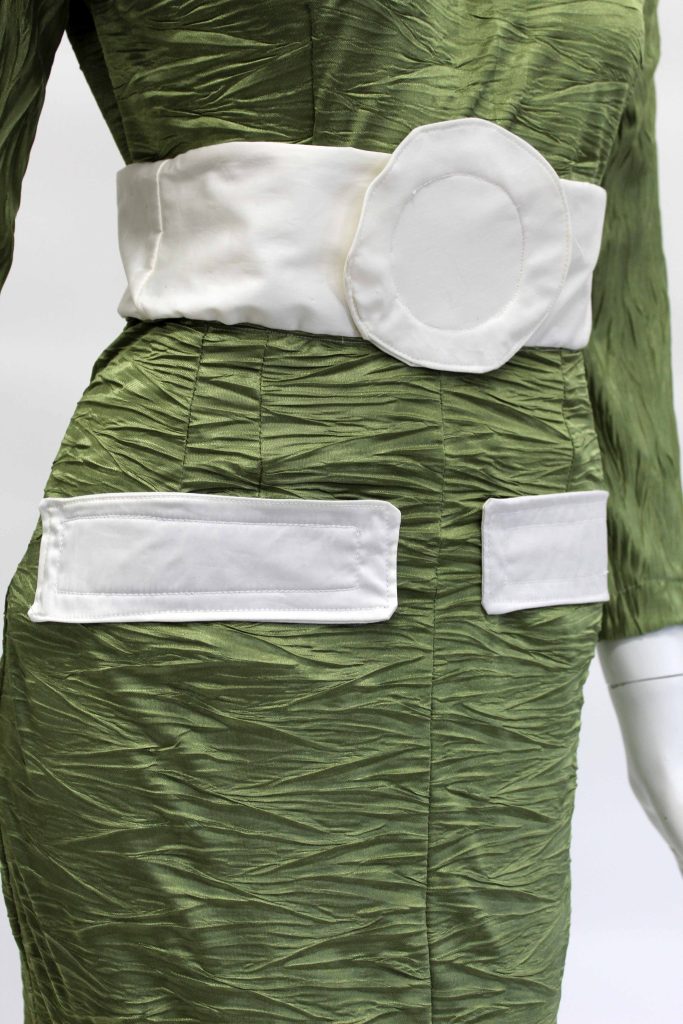
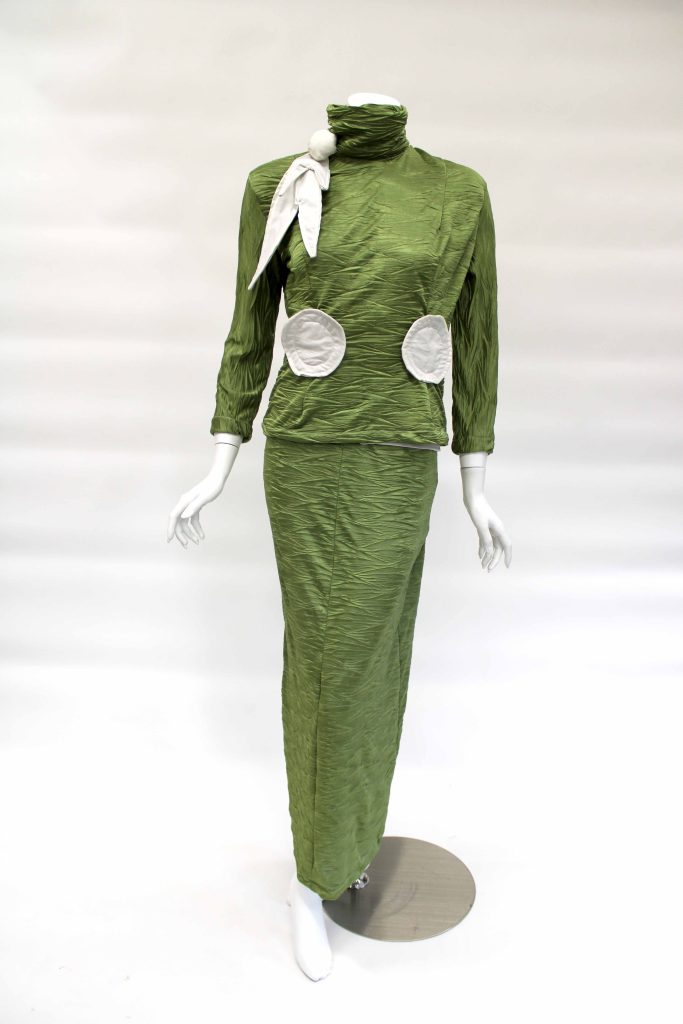
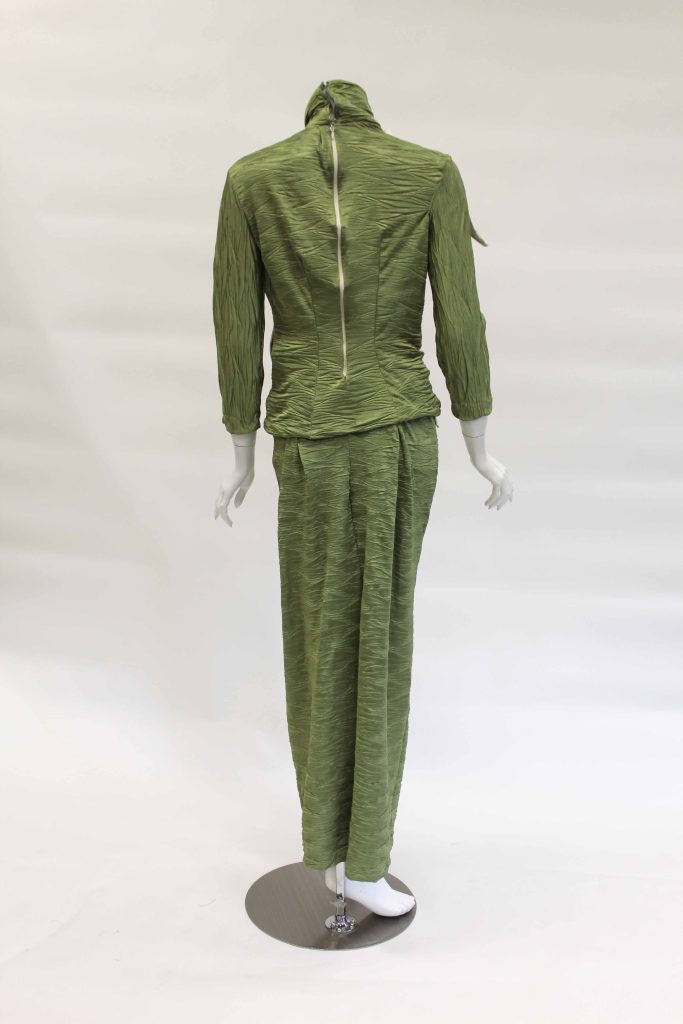
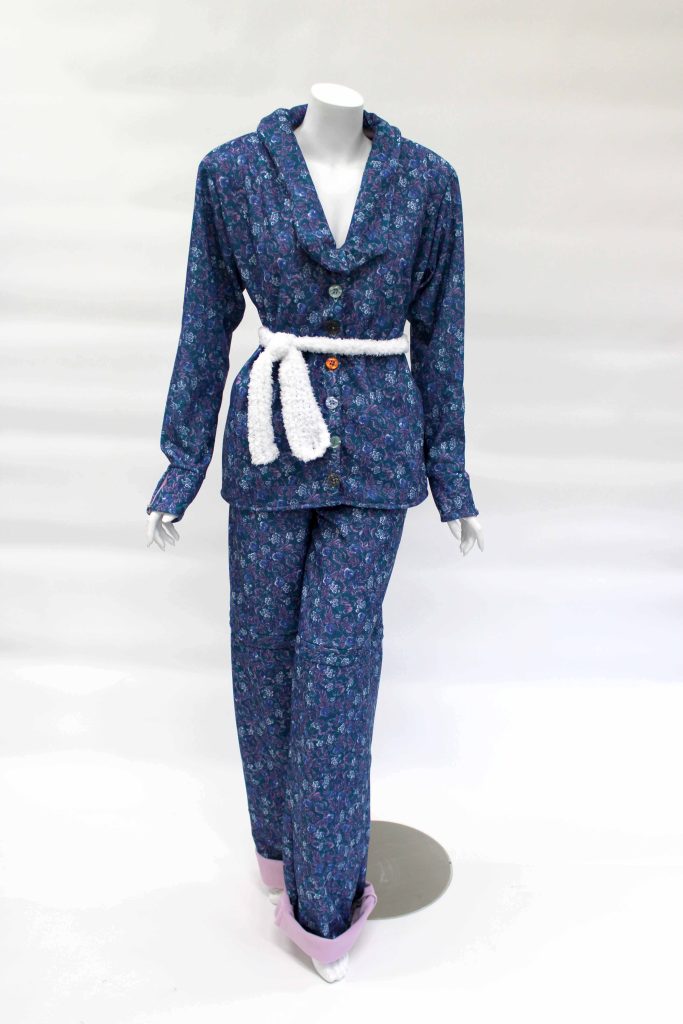
ALANA OSBORNE
Working Woman
“Part of the women’s rights movement of the 70s was the large disparity in pay between men and women from which I wanted took inspiration. This was also the decade when the Ginger Rogers Show was touring the country, so I also drew inspiration from the outfits in the show. When designing this garment, I wanted to have an oversized fit as that was becoming popular at the time. I kept the feminine aspect by cinching the waist with a hand-crocheted belt, a popular look of the 70s. My goal was to create a suit-like design to incorporate the women’s rights aspect and women in the workforce. I added shoulder pads to dramatize this. I wanted the pants to be a little too long, so I could roll them up which represents women putting on their husband’s pants to go work while they’re off at war. I came up with this idea because when women borrow their man’s clothes, they tend to be oversized on them.”
“For the pants design, I wanted to have a way to turn them into shorts, as a symbol of women coming home from work only to work their second job: being a wife and/or mother. Shorts are more comfortable, so I envisioned a woman coming home from work and walking into her house, taking off her jacket and unzipping the pant legs to be more comfortable while working at home. My final garment is made entirely from donated fabric and buttons from the City Sewing Room in St. Louis and cost me a total of 10 dollars.”

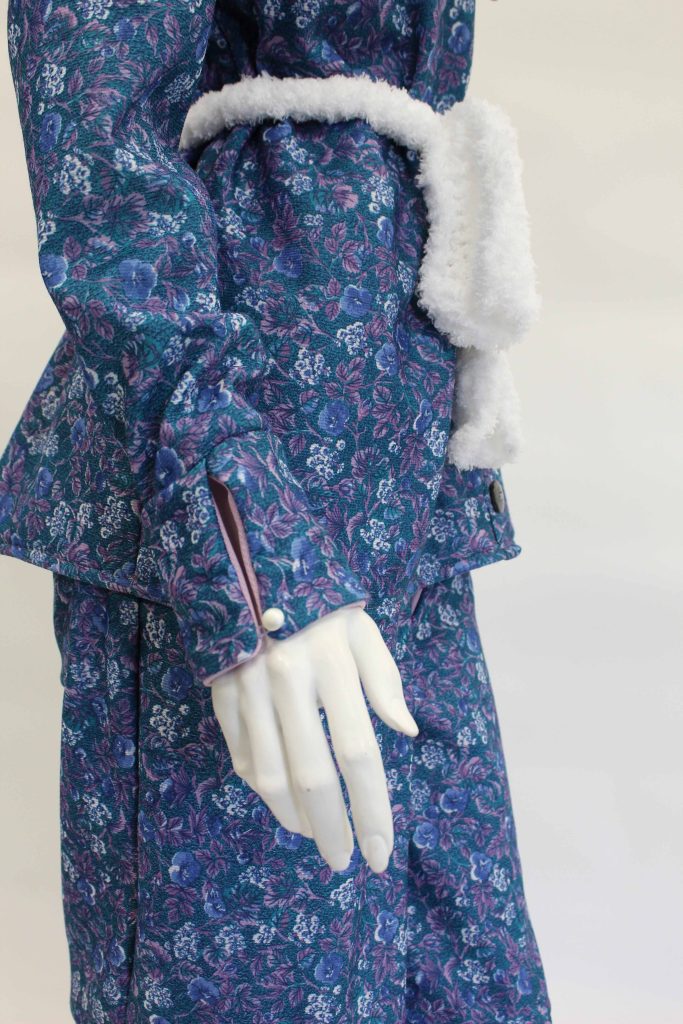
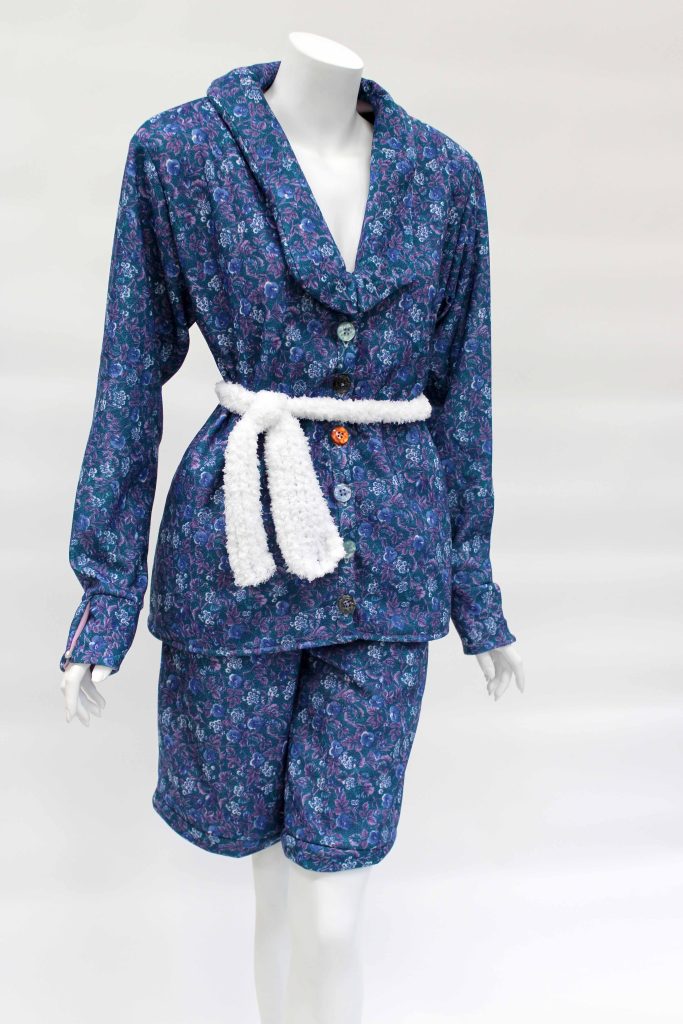
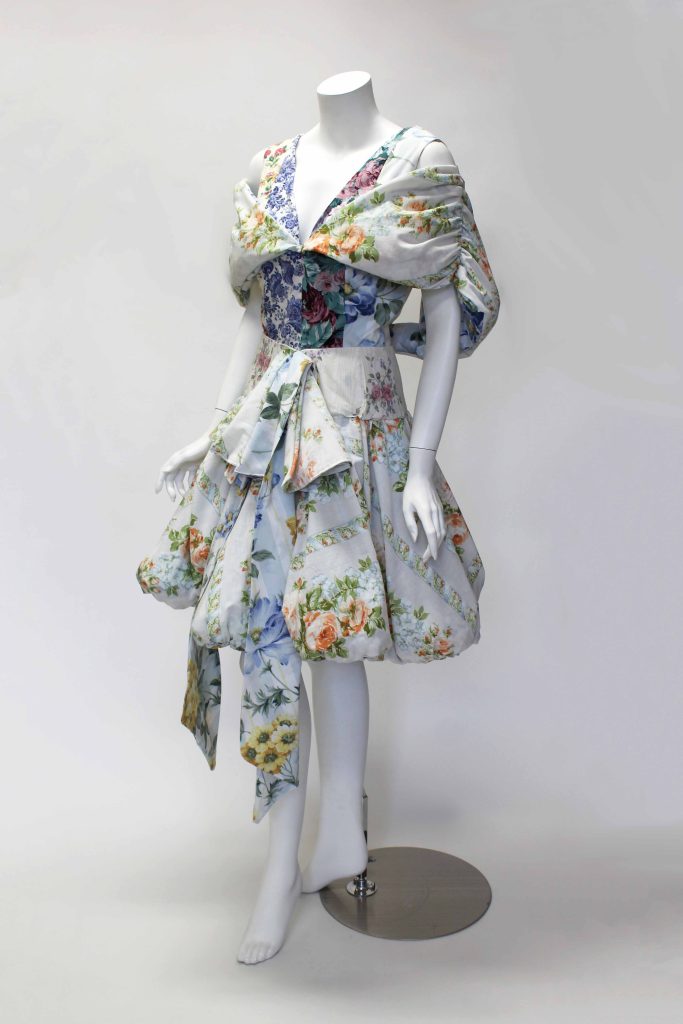
TARA OWENS
Penelope Gown
“The Penelope Gown signifies beauty and youth within, which Ginger Roger’s always radiated. With inspiration from Ginger such as feminine silhouettes, movement, and a “more is always better” mentality, this gown showcases all of Ginger’s exquisite attributes. If Ginger were to have had a daughter, I would like to think she would have worn this as she laughed and frolicked amidst the pastures in Oregon; butterflies would have flown past as she danced to her own beat.
This piece is also inspired by 1950s Vogue and lifestyle magazines, showing full and sleek gowns with defined style lines. Women were beginning to change history as they steered away from the typical housewife stereotype. Besides encapsulating confidence and positivity, it’s important to know sustainability is a major factor in this design. The dress was constructed from all thrifted material, each piece holding its own story but coming together to be something greater, just as women started to do in the 1950s. The Penelope Gown is also a zero-waste pattern, meaning that all scrap fabric was cut to be used as stuffing within the skirt and sleeves. As the designer, I hope this piece brings joy to the viewer and pride to live in a country with trailblazing women who fought for change.”
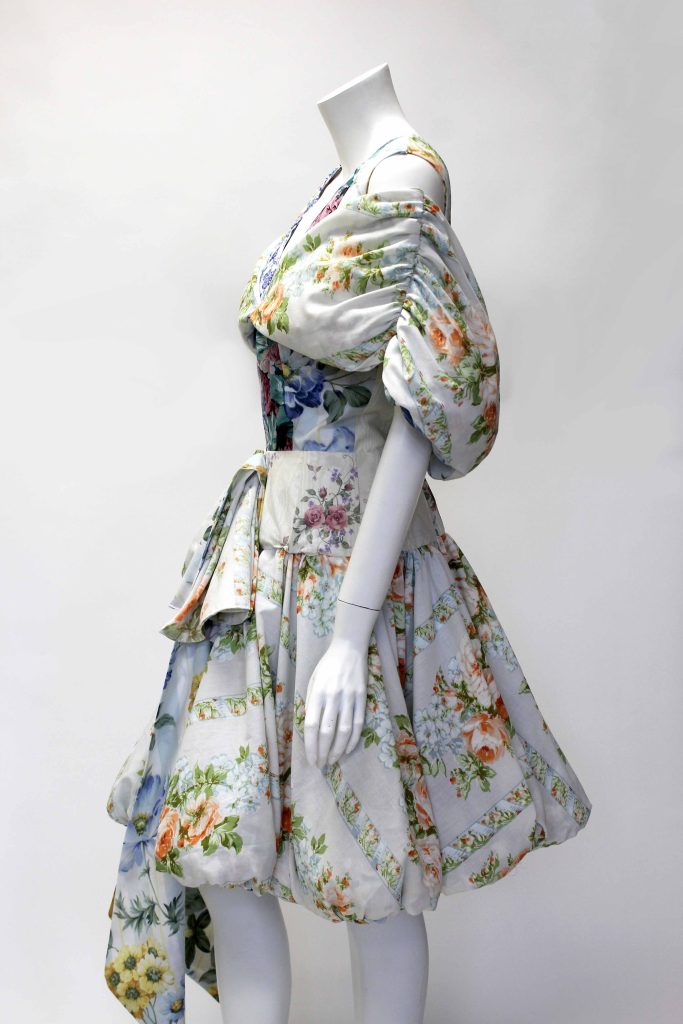
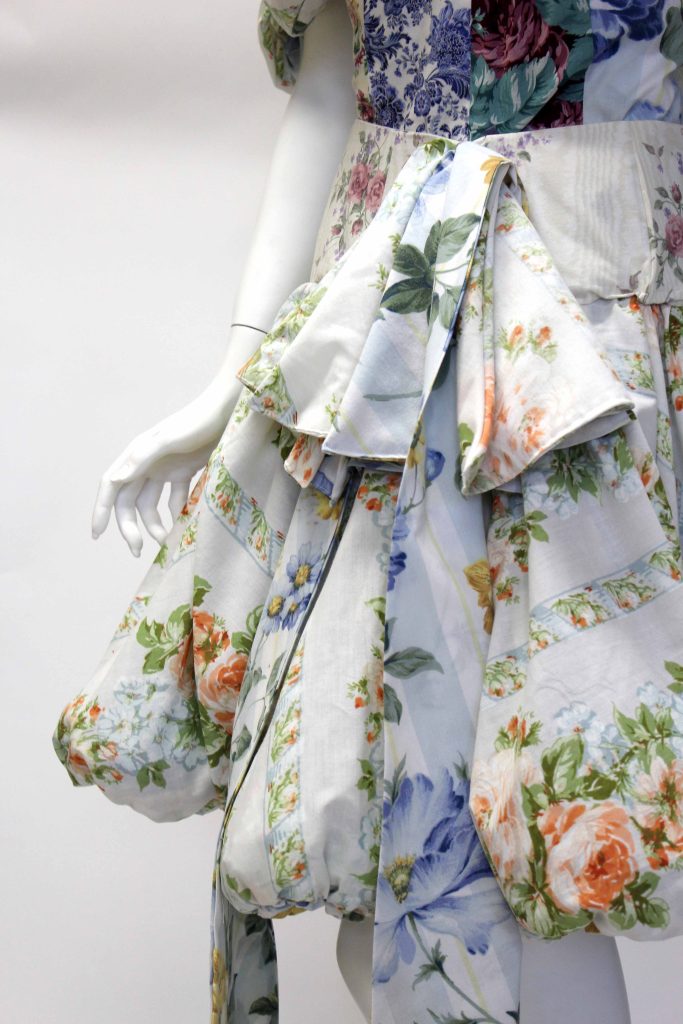
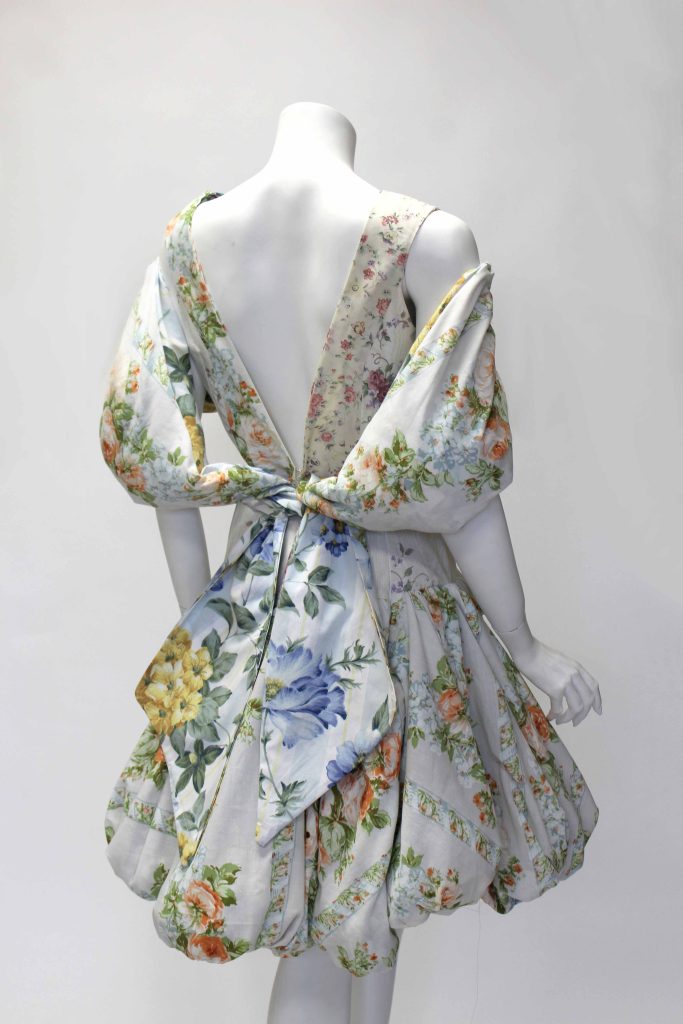
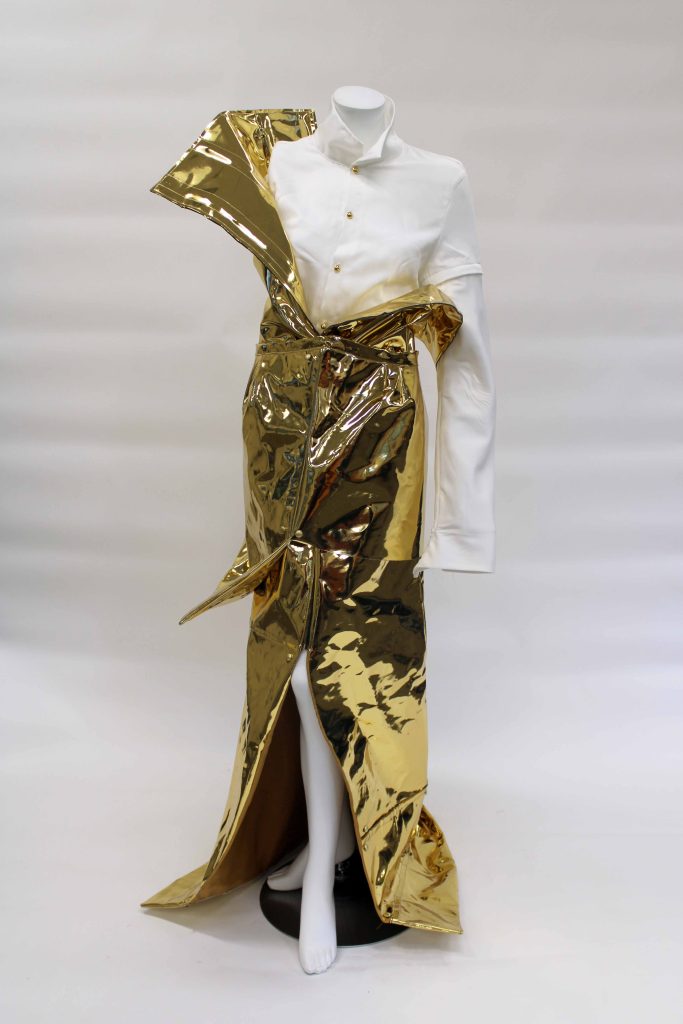
ZACK RACKERS
To Freedom and the Moon
““You have to stand for something, or you will fall for anything.” This Ginger Rogers quote is the basis for my design. This golden and structured dress is meant to stand as a symbol of strength and equality. “To Freedom” is the movement and pursuit of equality that minority groups fought for back in the 1960s and even to this day. “The Moon” is the goal of equality that minority groups were pursuing. Ginger Rogers wanted people to stand up for something that they truly believe in. I am choosing to stand for equality and freedom. The Civil Rights Movement, Gay Rights Movement, and the Women’s Rights Movement in the 1960s were elements that I specifically wanted to focus on for this dress. This dress is an inspiration for those who see it to stand up for what they know to be right. The idea behind this design is from a picture of a woman inspecting a metal sheet (see presentation page 2.) It made me want to construct a dress that looked like it was made of metal, one that looked strong and indestructible.”
“For this design, I used different pattern making techniques. I used dart manipulation to move a dart from the waist to the armpit on the front bodice pattern piece. I specifically chose to make stream-lined edges and shapes to give this dress a structured and aerodynamic look, specifically modeled after a spaceship. A spaceship encapsulates the strength of my design, the space race in the 1960s, and the pursuit towards “the moon” or the equality that these groups fought towards.”

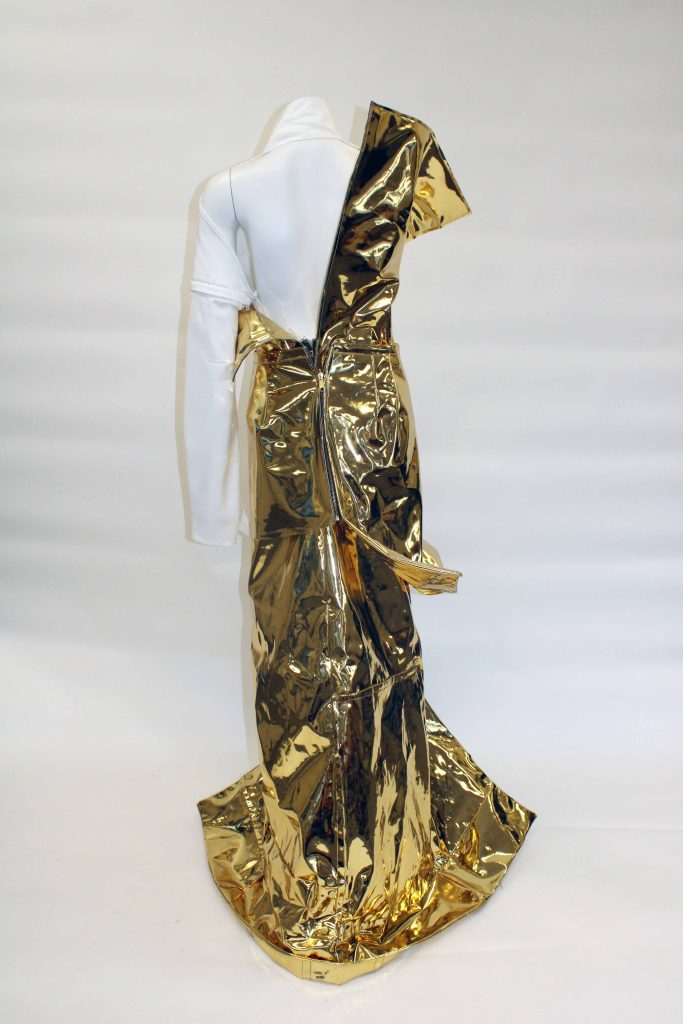
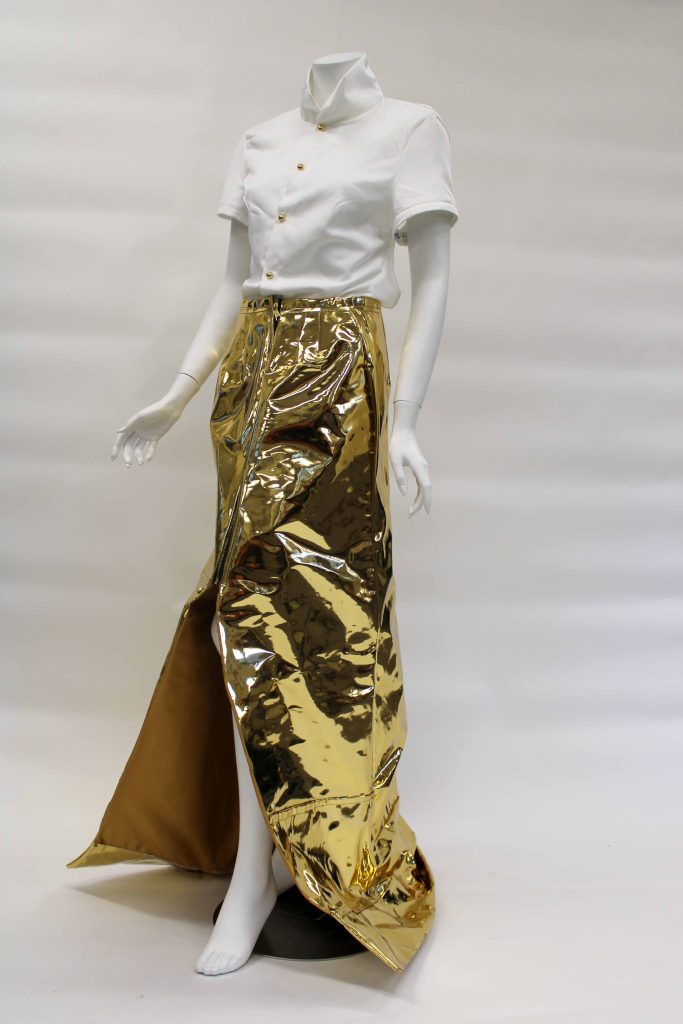
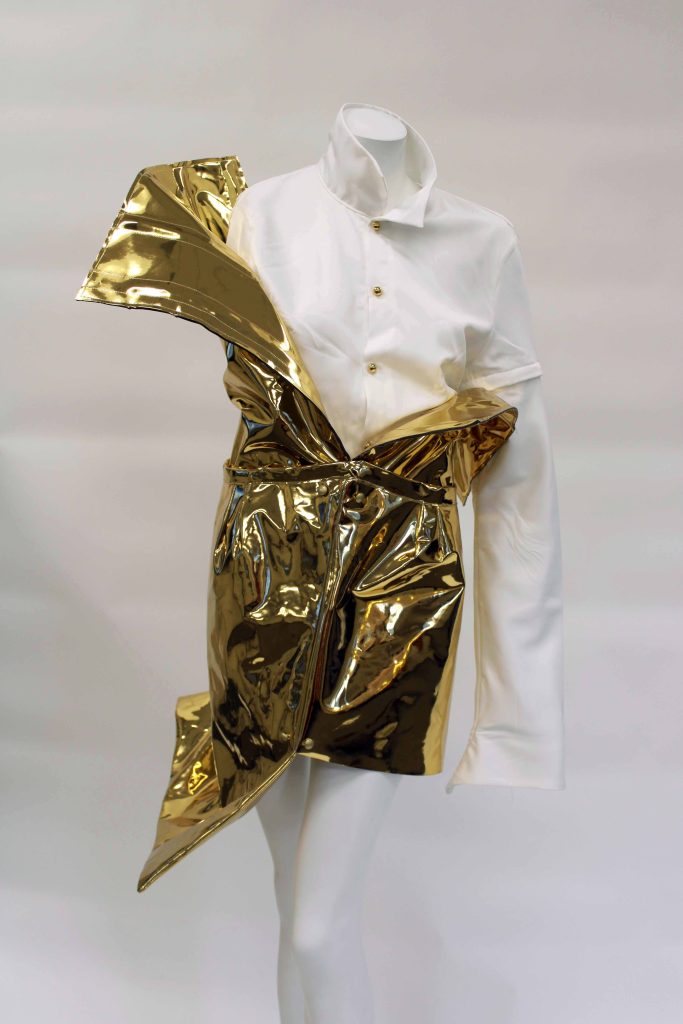
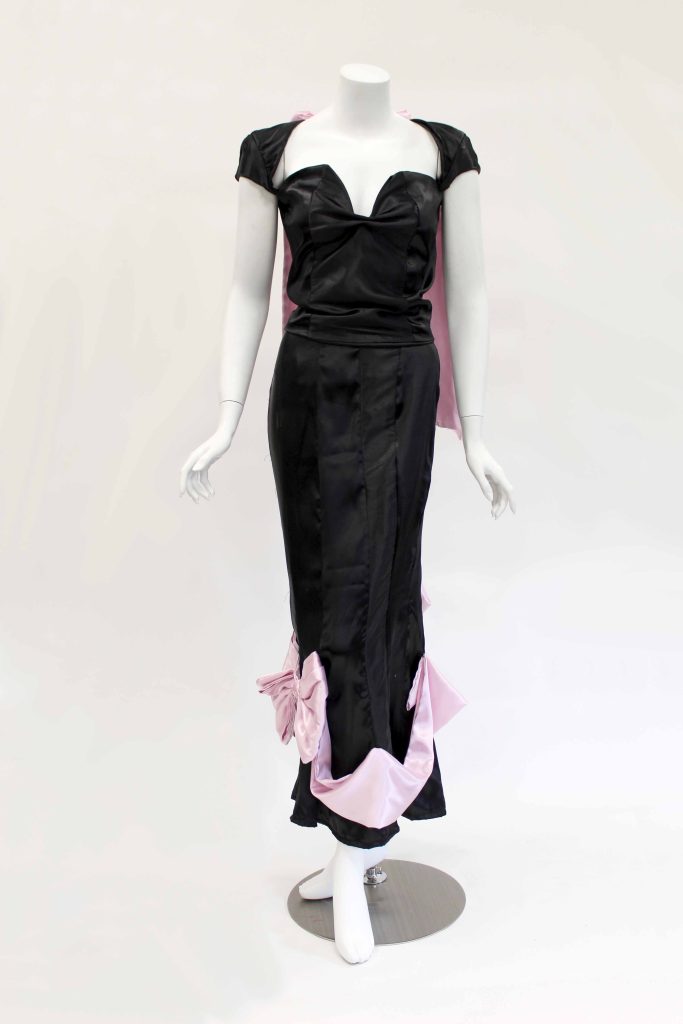
CARLIE SCARPACE
1950s Chic
“My final ensemble includes a sweetheart neckline bodice and mermaid-style skirt. I took inspiration from the famous Hollywood actress Ginger Rogers and her grace and glamour as a woman. I incorporated this by adding bows, a princess seam, and a mermaid skirt which all portray femininity. I also chose to take inspiration from popular 1950s architecture such as Googie and Mid-Century Modern. I utilized this by adding seamlines to create a structured look that accentuates curves, similar to construction within Googie and Mid-Century Modern. Lastly, I chose to take inspiration from 1950s poodle skirts and bold color pairings such as black and pink. These were both popular during this time. After WWll had ended, people were searching for a more vibrant and fun aesthetic, leaving behind the somber one of wartime. To create this design, I constructed my own pattern pieces for each section of my garment. I first designed the bodice with paper and then transitioned to CLO 3D to construct my skirt. I used CLO to elongate my skirt and add flare at the ankles. My goal was to create my version of a poodle skirt as I incorporated all areas of my inspiration.”
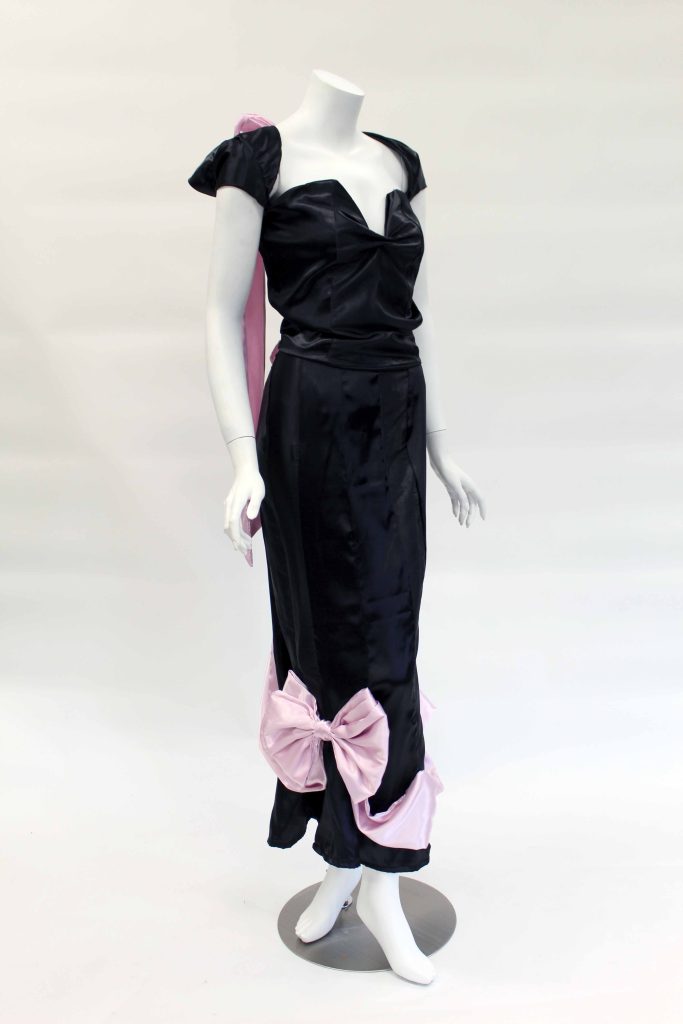
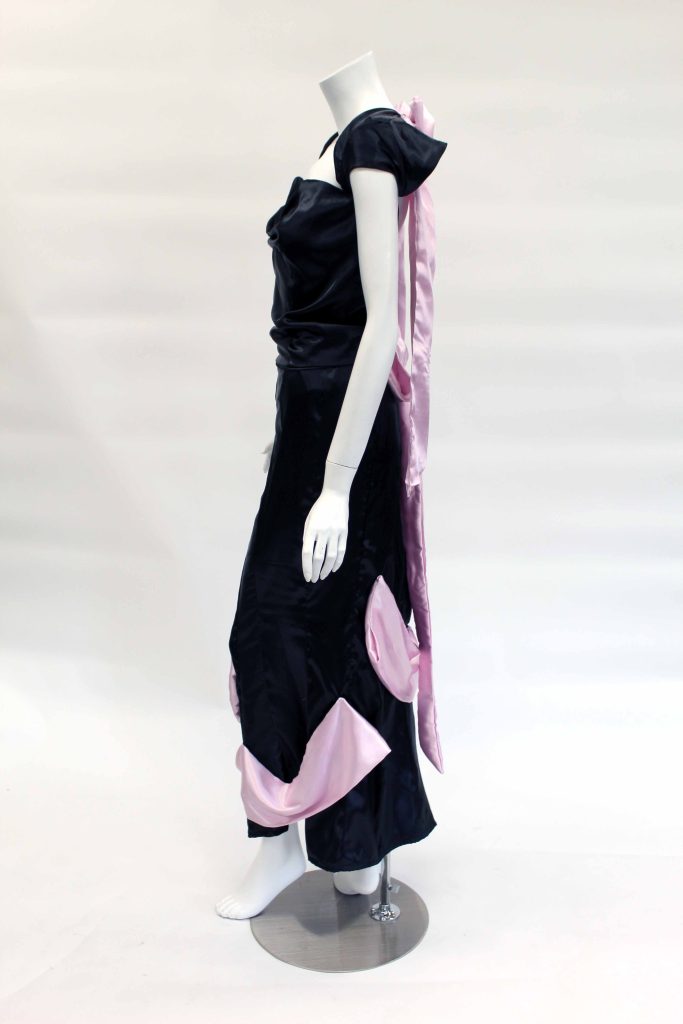
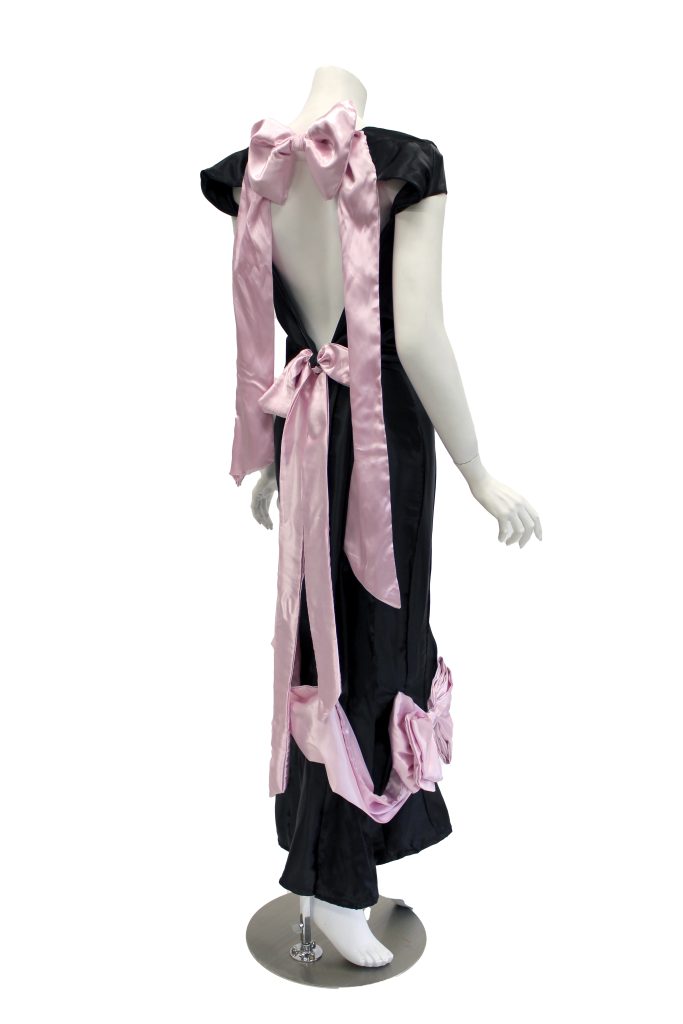
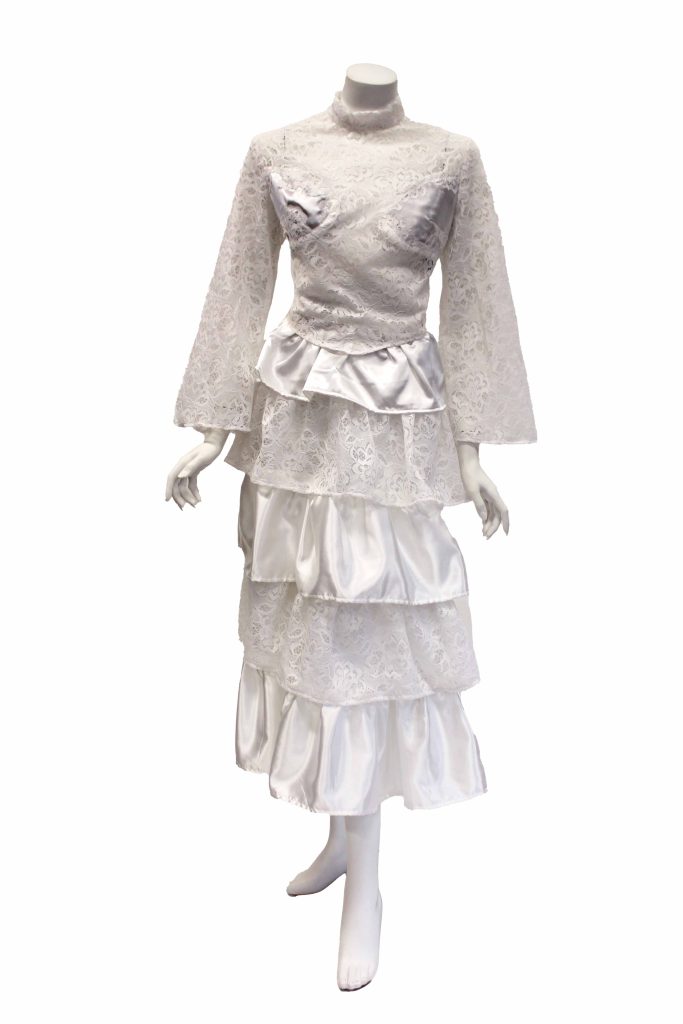
CAILEY SOUTHARD
Juxtaposed Romance
“I was tasked with creating a bodice and skirt taking inspiration from Ginger Rogers and the 1950s. Ginger was married several times, and I found much of my inspiration from 1950s bridal wear. During World War II, there was fabric rationing, limiting the capabilities of garments made. Postwar in the 50s, the rationing ended, and big, full skirts became popular. I wanted to create a wedding dress that included a full skirt that hit mid-calf, a style also popular in the 50s. For the bodice, I was inspired by Ginger’s tendency to be a bit risqué. I created an almost full lace front, with just a small portion covered with satin fabric. The name “Juxtaposed Romance” combines the revealing bodice with the sense of purity from the white color. These two things contradict each other but fit together to be a wedding dress for someone’s most romantic day. I made my pattern pieces from scratch using a variety of patternmaking techniques. Creating my own patterns helped me to understand how garments can be manipulated to fit the body in different ways and how one simple change can make all the difference.”
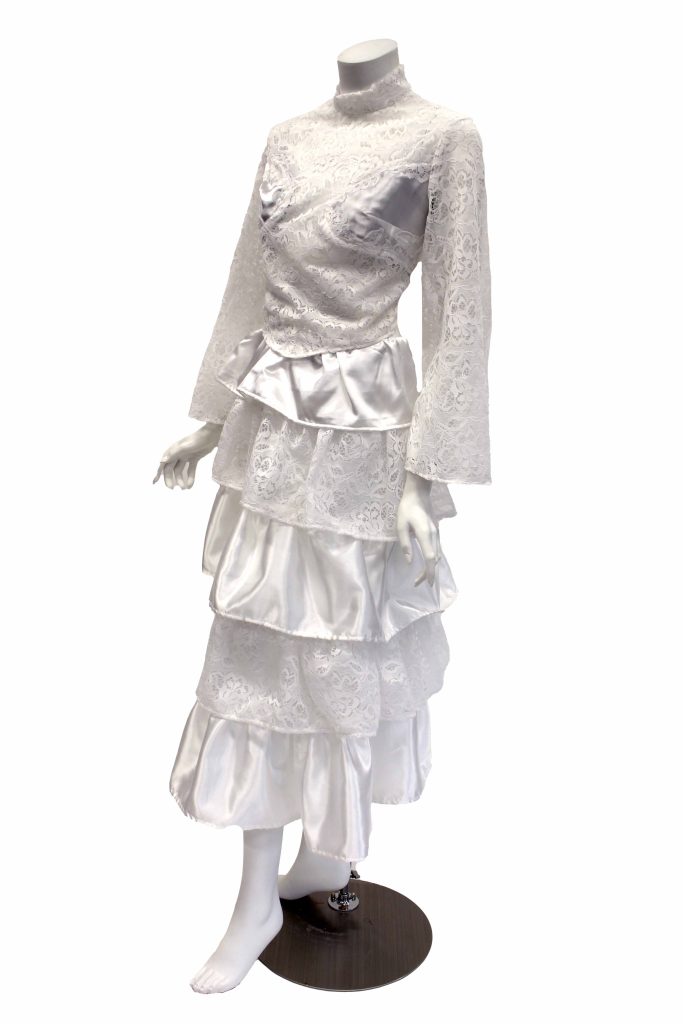

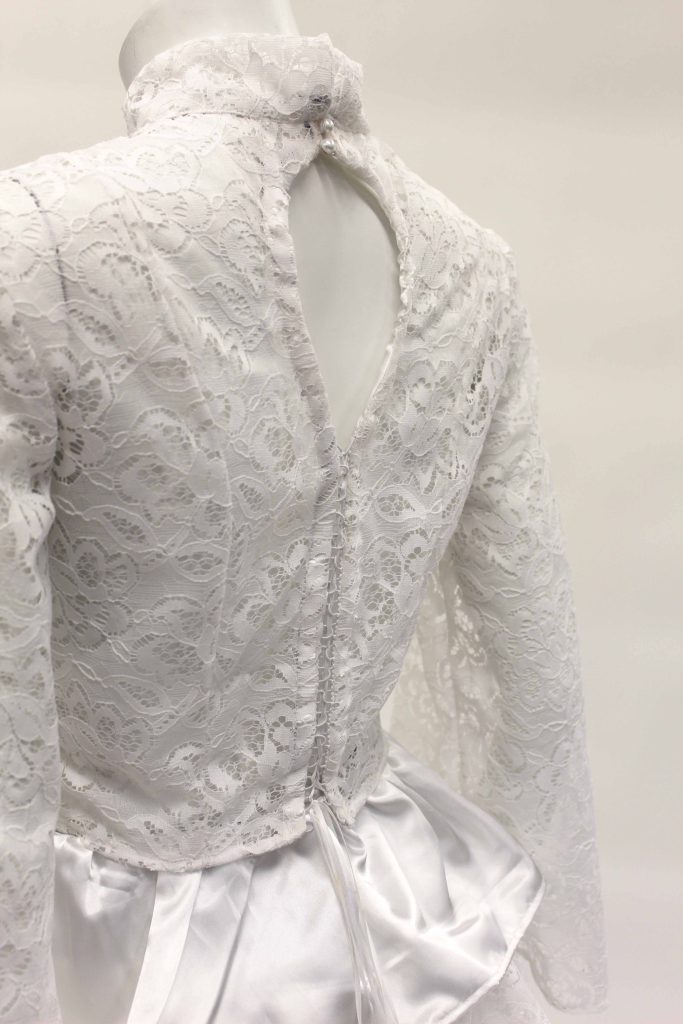
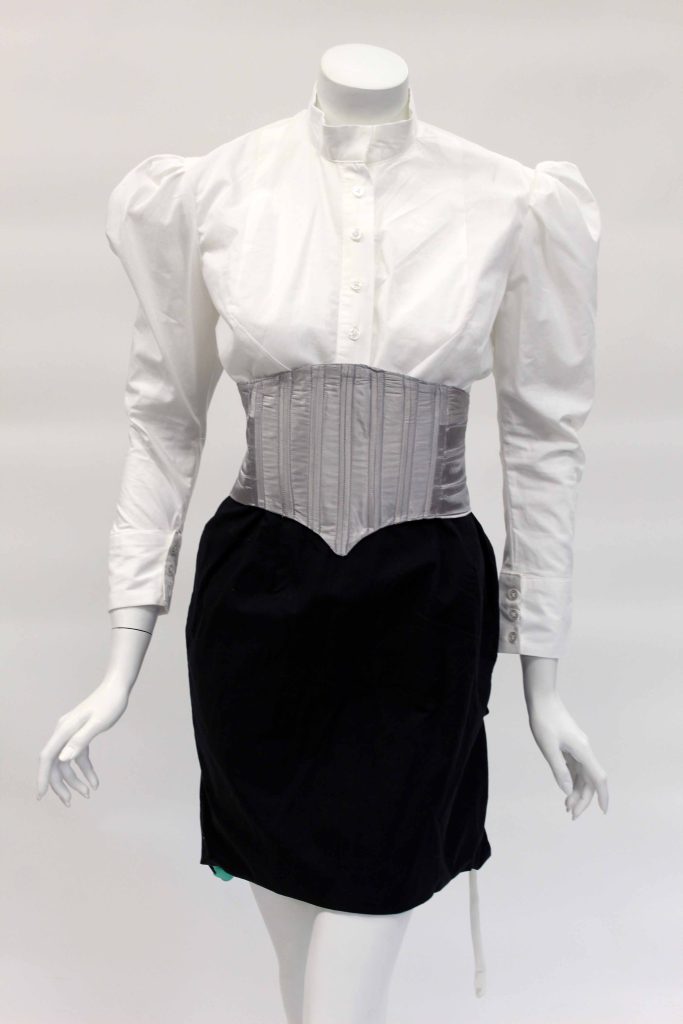
TEAGHEN SPEIER
Industrial Demure
“I decided to lean away from what felt most comfortable and push into subjects far more foreign. After initially pushing for the1950s, I instead found myself inspired to try out the 1930s and although this decade was not my first choice, I became overwhelmed with inspiration. Before I knew it, I was seeking inspiration from vintage cars, colors, shapewear, all while adding my own Ginger Rogers flair. My vision however would not have been complete without the help of several patternmaking techniques. Considering I found inspiration in vintage shapewear, I wanted to incorporate a pointed bust in my design [like those of 1950s brassieres.] In order to do this, I had to not only manipulate the darts in my bodice but extend them each to the apex to make for a very sharp tipped effect. When it came to my inspiration with vintage cars, I knew I wanted to rely heavily on the line work within the grill, so I made a corset from scratch with the sections alluding to the appearance of metal bars. Working with CLO3D, I was able to fully see how the train of my skirt would be bunched up to form a bustle; this is one of the main reasons why I felt it came out so successfully.”
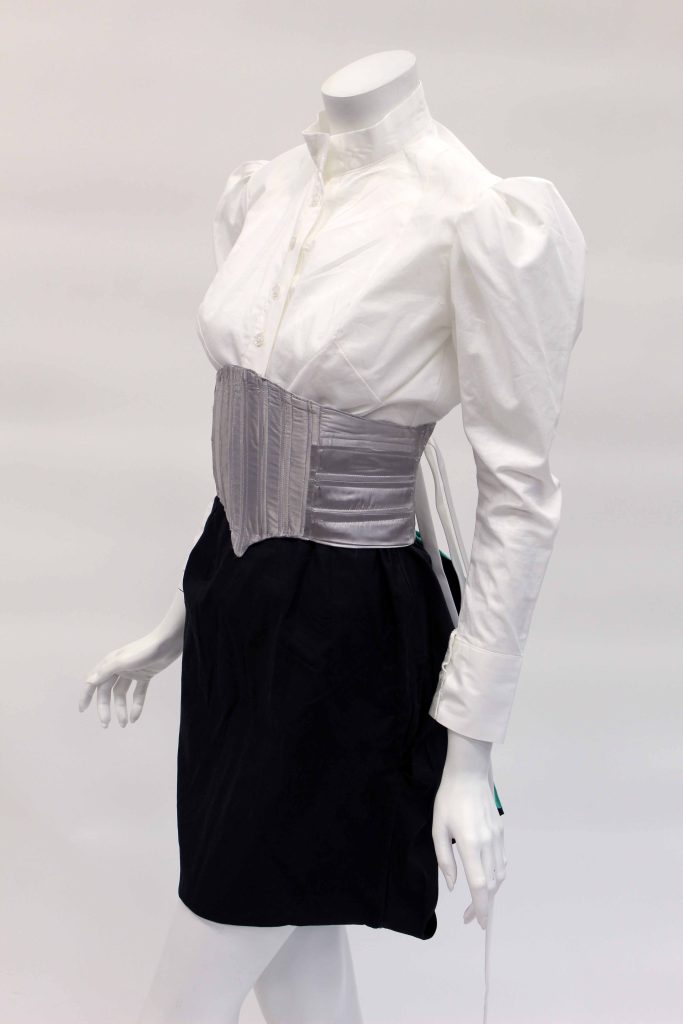
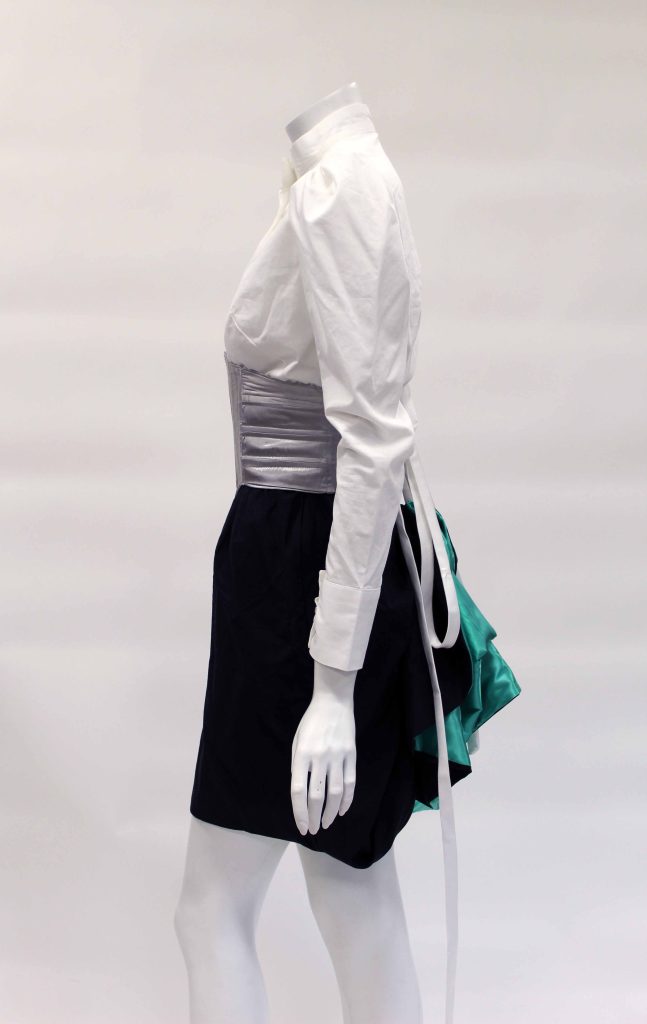
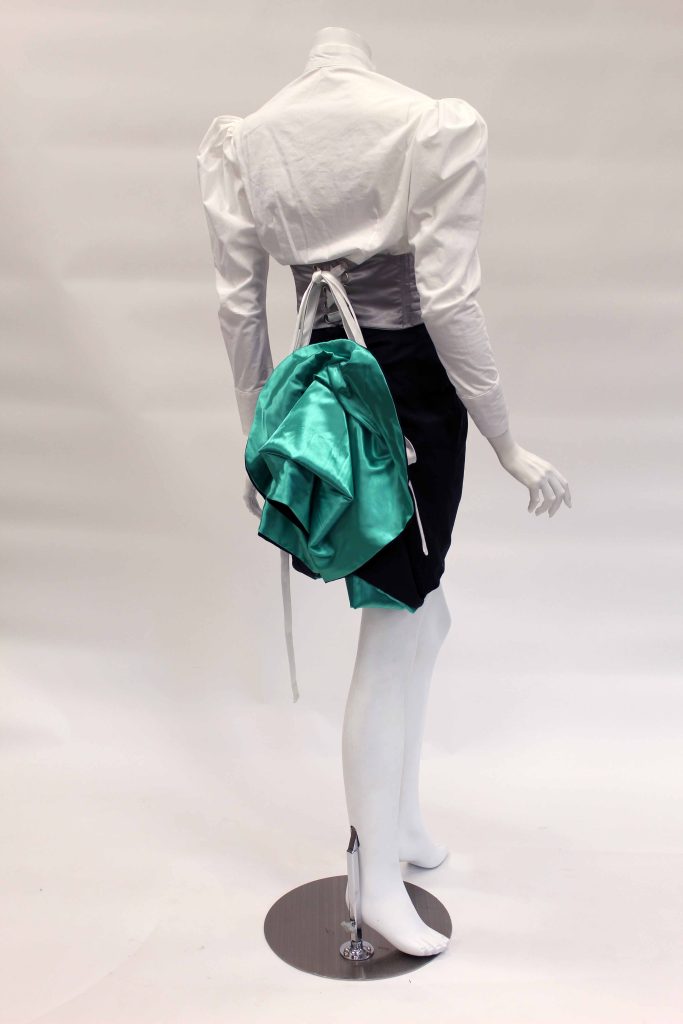
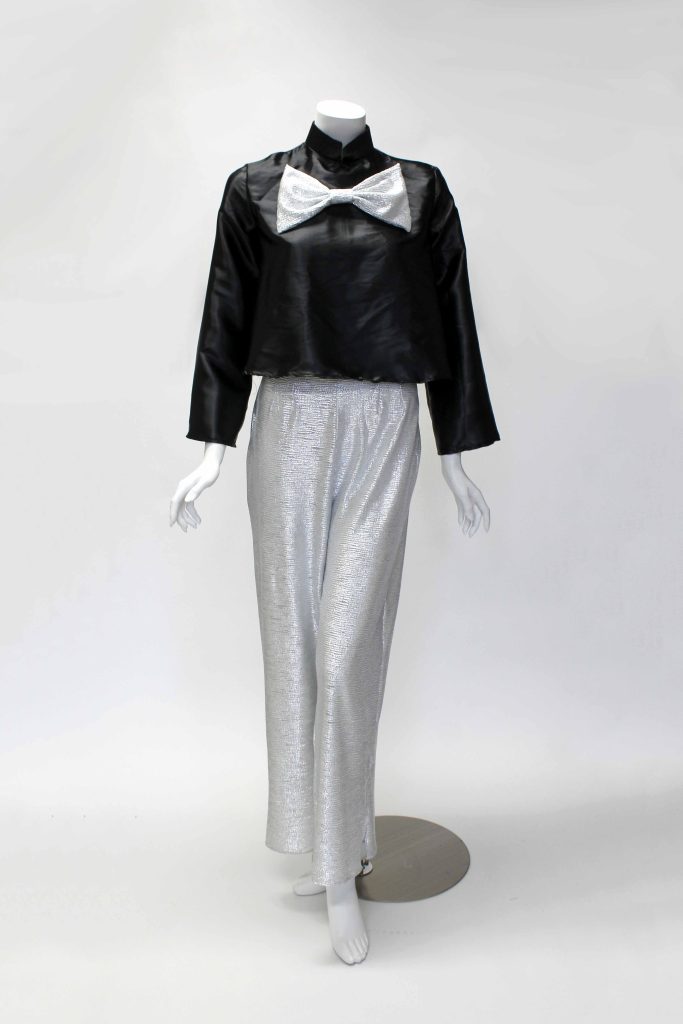
EMMA VOLK
Retronova
“”Retronova” is a design concept inspired by the bold and distinctive shapes of the 1960s Space Age. Drawing from the optimistic era of space exploration, this concept integrates geometric precision, futuristic silhouettes, and innovative materials to create a visual narrative that transcends time. This ensemble introduces an influence of defined shapes, breaking away from traditional design norms. Much like the architecture of this time, this garment plays with shapes and creates a unique but sophisticated appeal. Shiny metallic finishes and reflective surfaces pay homage to the era’s fascination with high-tech aesthetics, which influenced my fabric choices. This concept is also deeply rooted in the strong work ethic of Ginger Rogers. Minimalist elements were utilized to ensure a focus on essential, functional forms, allowing this garment to be worn in any business casual setting. “Retronova” is tailored for versatility and invites individuals to embark on a journey through space and time, offering a contemporary reinterpretation of the Space Age legacy.“
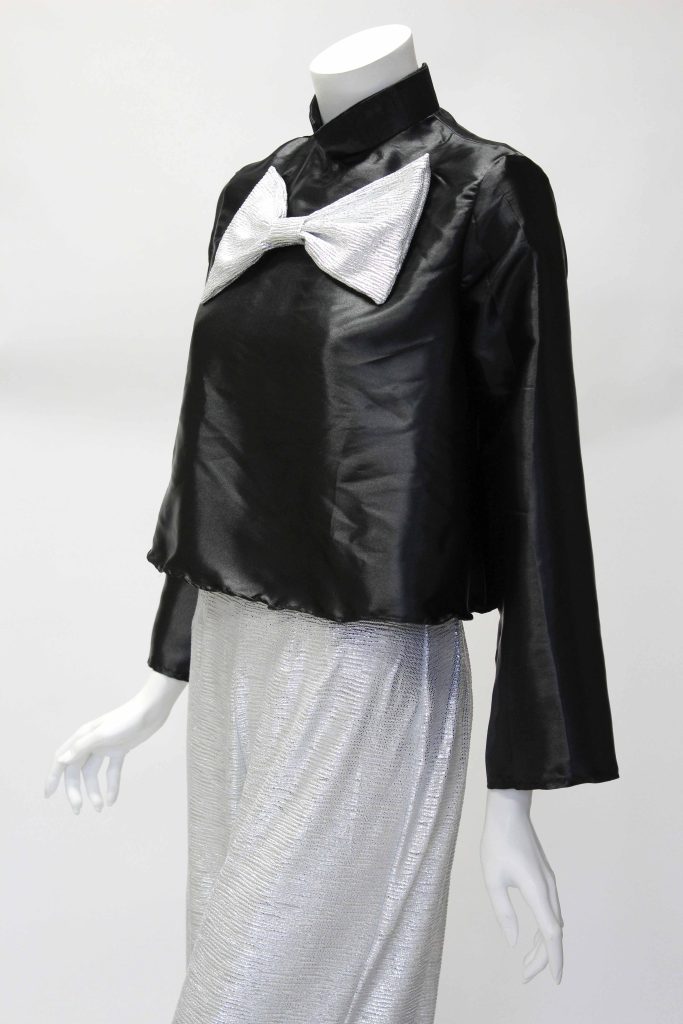
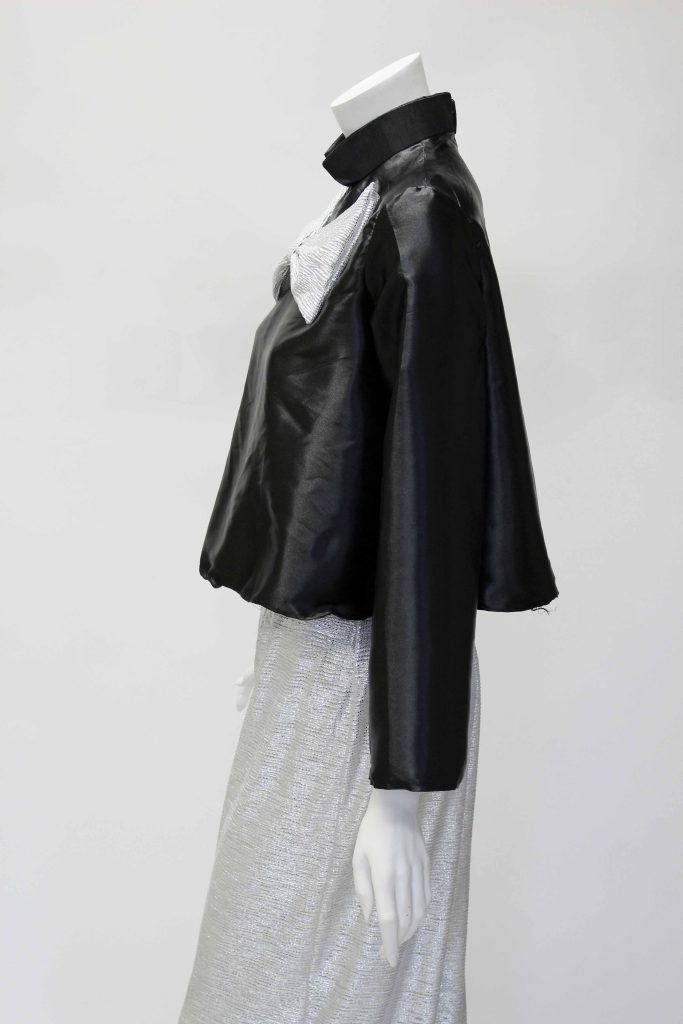
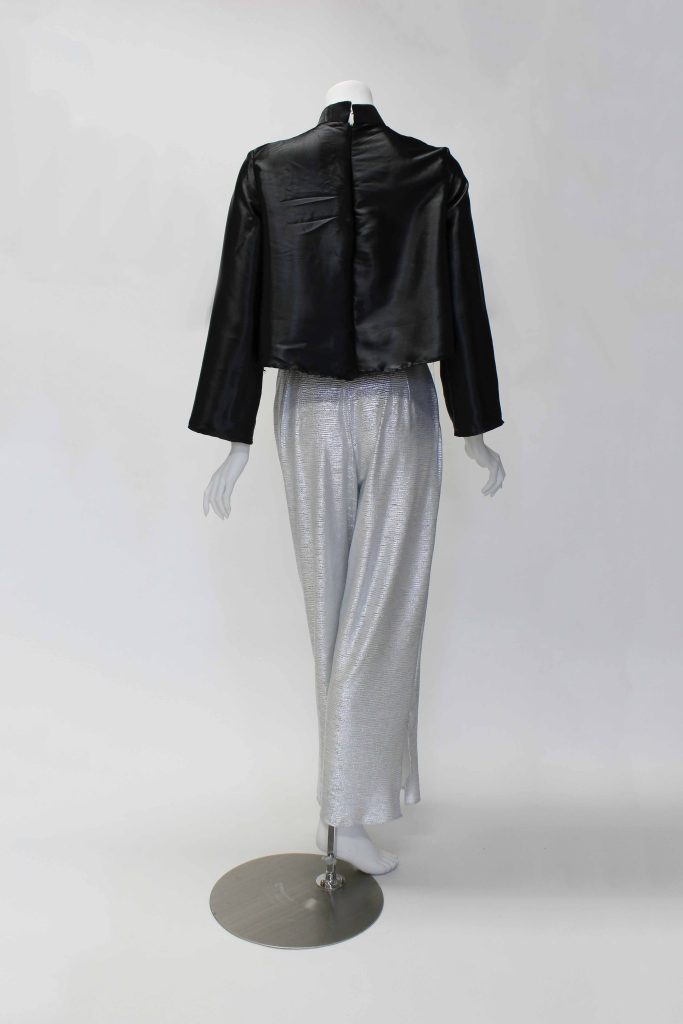
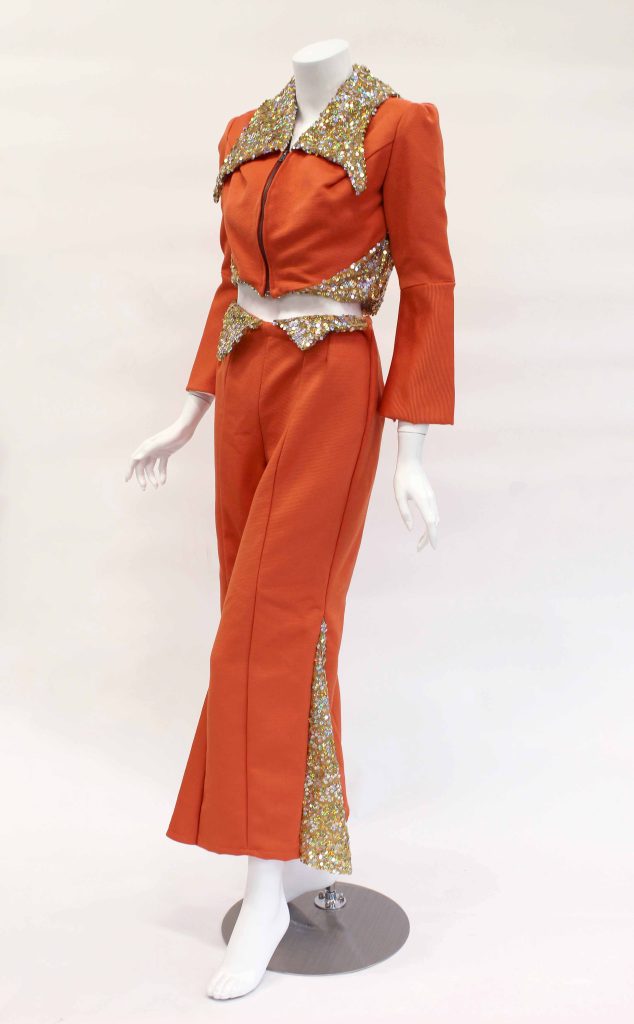
AIRI WASHINGTON
Ginger: Golden
“My design takes inspiration from the 1960s including the civil rights movement, the MOD movement and counterculture. In addition, I also found inspiration from Paco Robanne’s work in the 60s and from the disco movement. I used the disco ball and orange record from the 60s and used that to be additional design inspirations. Lastly, I took inspiration from Ginger Rogers and her always being extravagant. In the patternmaking process, I made patterns by hand. I used slash and spread techniques to move darts to where I wanted them and also used style lines to make a more curved look to the bodice. I used CLO3D to make the pants, adding style lines and fullness. The main color of the design is orange which was a prominent color in the 60s and had the boldness of Ginger. I incorporated a sparkling sequin tulle to bring in the disco aesthetic even more. The design has a good mix of inspiration and imagination to create a familiar feel and new experience all at once. The collar on the pants was meant to be a bold new look not typically seen in the 60s. It brings in a newer trend on a vintage style.”
